As the site is updated, each listing includes the shipping cost. Some listings which I have not updated still give you calculated shipping costs based on weight and size of package. (In the sections I have updated) If you select several different listings, we will consolidate your order and charge you the actual cost of the entire package. The shipping over charge will be refunded to you, when your order is shipped.
CORAL
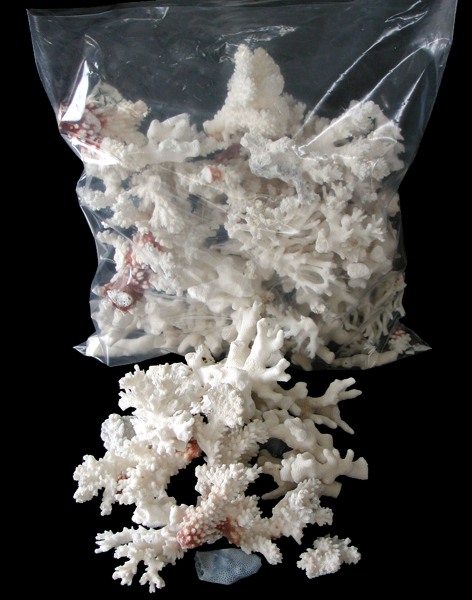
Broken Coral
Broken Coral is sold assorted type and size. Cannot provide a specific size or type. The type can vary from picture.
BC1-1
One quarter pound of broken coral pieces, ranging in size from 1/2 inch to 4 inches......... $9.20
BC1-11
One half pound of broken coral pieces, ranging in size from 1/2 inch to 4 inches......... $13.62
BC1-111
One pound of broken coral pieces, ranging in size from 1/2 inch to 4 inches......... $25.69
BC1-1111
Five pound of broken coral pieces, ranging in size from 1/2 inch to 4 inches......... $85.35
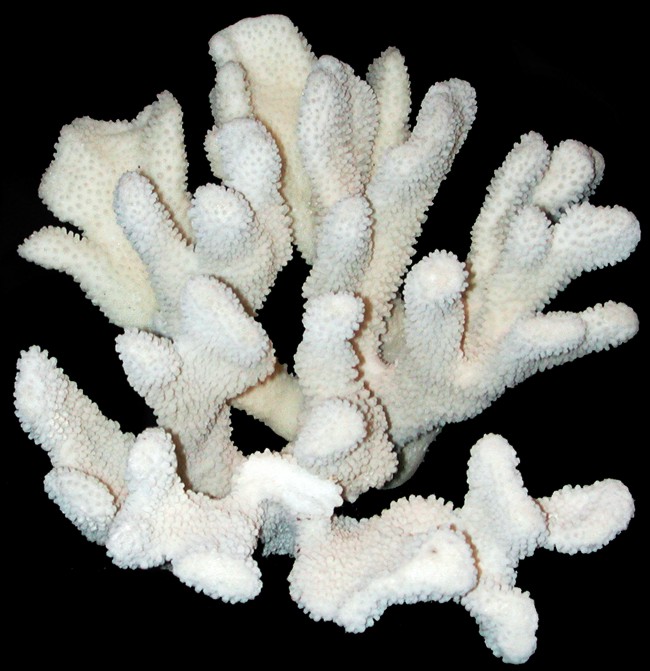
Stylophora common name cat's paw coral
These are in the genus of colonial stony corals part of the family Pocilloporidae. They are native to the Red Sea, the Indo-Pacific region and eastwards as far as the Pitcairn Islands.
Members of this genus are branching corals. The finger-like branches vary in width and have blunt tips. The growth forms and colors are variable depending on many factors, including the level of light and the amount of water movement. The color may be orange, pink, magenta, purple, green or brown.
Scientific classification
Domain: Eukaryota
Kingdom: Animalia
Phylum: Cnidaria
Class: Hexacorallia
Order: Scleractinia
Family: Pocilloporidae
Genus: Stylophora
Schweigger, 1820
(REF: Hoeksema, B. (2018). "Stylophora Schweigger, 1820". WoRMS. World Register of Marine Species.)(REF: Sprung, Julian (1999). Corals: A quick reference guide. Ricordea Publishing.)
coral branches shape can vary.
CP0-100
One Cat's Paw Coral branch measuring 5 to 7 inches .... OUT OF STOCK
CP1-100
A Cat's Paw Coral cluster measuring 7 to 9 inches......$56.25
CP2-100
One Cats Paw Coral cluster measuring 9 to 11 inches ......$82.86
CP3-100
One Cat's Paw Coral cluster measuring 11 to 13 inches..... OUT OF STOCK
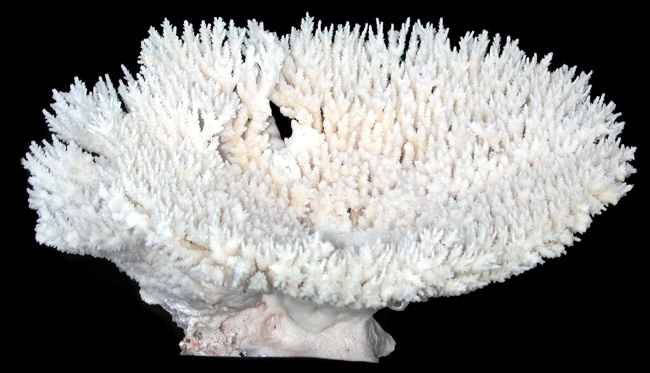
TABLE CORAL
Coral cluster shape can vary.
TC1-100
One Table Coral Cluster measuring 7 to 10 inches...... OUT OF STOCK
TC2-100
One 10 to 12 inch Table Coral cluster....OUT OF STOCK
Acropora common name TABLE CORAL for one of several species within this genus.
This is a genus of small polyp stony coral in the phylum Cnidaria. Other species within the Acropora genus are known as elkhorn coral, and staghorn coral. This genus consists of over 149 species. Acropora species are some of the major reef corals responsible for building the immense calcium carbonate substructure that supports the thin living skin of a reef.
stony corals or hard corals, are marine animals in the phylum Cnidaria that build themselves a hard skeleton. The individual animals are known as polyps and have a cylindrical body crowned by an oral disc in which a mouth is fringed with tentacles. Although some species are solitary, most are colonial. The founding polyp settles and starts to secrete calcium carbonate to protect its soft body. Solitary corals can be as much as 10 inches across but in colonial species the polyps are usually only a few fractions of an inch in diameter. These polyps reproduce asexually by budding, but remain attached to each other, forming a multi-polyp colony of clones with a common skeleton, which may be up to several feet in diameter or height according to species.
Depending on the species and location, Acropora species may grow as plates or slender or broad branches. Like other corals, Acropora corals are colonies of individual polyps, which are less than an inch across and share tissue and a nerve net. The polyps can withdraw back into the coral in response to movement or disturbance by potential predators, but when undisturbed, they protrude slightly. The polyps typically extend further at night to help capture plankton and organic matter from the water.
More than 100 species are distributed in the Indo-Pacific and 3 have been found in the Caribbean. The true number of species is unknown: the validity of many of these species is questioned, as some have been shown to represent hybrids, for example Acropora prolifera; and some species have been shown to represent cryptic species complexes.
Symbiodinium, symbiotic algae, live in the corals' cells and produce energy for the animals through photosynthesis. Environmental destruction has led to a dwindling of populations of Acropora, along with other coral species. Acropora is especially susceptible to bleaching when stressed. Bleaching is due to the loss of the coral's zooxanthellae, which are a golden-brown color. Bleached corals are stark white and may die if new Symbiodinium cells cannot be assimilated. Common causes of bleaching and coral death include pollution, abnormally warm water temperatures, increased ocean acidification, sedimentation, and eutrophication.
Coral bleaching is the process when corals become white due to loss of symbiotic algae and photosynthetic pigments. This loss of pigment can be caused by various stressors, such as changes in temperature, light, or nutrients. Bleaching occurs when coral polyps expel the zooxanthellae (dinoflagellates that are commonly referred to as algae) that live inside their tissue, causing the coral to turn white. The zooxanthellae are photosynthetic, and as the water temperature rises, they begin to produce reactive oxygen species. This is toxic to the coral, so the coral expels the zooxanthellae. Since the zooxanthellae produce the majority of coral coloration, the coral tissue becomes transparent, revealing the coral skeleton made of calcium carbonate. Most bleached corals appear bright white, but some are blue, yellow, or pink due to pigment proteins in the coral.
he leading cause of coral bleaching is rising ocean temperatures due to climate change caused by anthropogenic activities. A temperature about 2 °F above average can cause bleaching. The ocean takes in a large portion of the carbon dioxide (CO2) emissions produced by human activity. Although this uptake helps regulate global warming, it is also changing the chemistry of the ocean in ways never seen before. Ocean acidification (OA) is the decline in seawater pH caused by absorption of anthropogenic carbon dioxide from the atmosphere. This decrease in seawater pH has a significant effect on marine ecosystems.
According to the United Nations Environment Program, between 2014 and 2016, the longest recorded global bleaching events killed coral on an unprecedented scale. In 2016, bleaching of coral on the Great Barrier Reef killed 29 to 50 percent of the reef's coral. In 2017, the bleaching extended into the central region of the reef. The average interval between bleaching events has halved between 1980 and 2016. The world's most bleaching-tolerant corals can be found in the southern Persian/Arabian Gulf. Some of these corals bleach only when water temperatures exceed 95 °F.
Most Acropora species are brown or green, but a few are brightly colored, and those rare corals are prized by aquarists. Captive propagation of Acropora is widespread in the reef-keeping community. Given the right conditions, many Acropora species grow quickly, and individual colonies can exceed a foot across in the wild. In a well-maintained reef aquarium, finger-sized fragments can grow into medicine ball-sized colonies in one to two years. Captive specimens are steadily undergoing changes due to selection which enable them to thrive in the home aquarium. In some cases, fragments of captive specimens are used to repopulate barren reefs in the wild.
Bleached corals continue to live, but they are more vulnerable to disease and starvation. Zooxanthellae provide up to 90 percent of the coral's energy, so corals are deprived of nutrients when zooxanthellae are expelled. Some corals recover if conditions return to normal, and some corals can feed themselves. However, the majority of coral without zooxanthellae starve.
Scientific classification
Domain: Eukaryota
Kingdom: Animalia
Phylum: Cnidaria
Class: Hexacorallia
Order: Scleractinia
Family: Acroporidae
Genus: Acropora
Oken, 1815
(REF: Wallace, C. C; Rosen, B. R (2006-04-22). "Diverse staghorn corals (Acropora) in high-latitude Eocene assemblages: implications for the evolution of modern diversity patterns of reef corals". Proceedings of the Royal Society B: Biological Sciences. 273 )(REF: WoRMS (2010). "Acropora Oken, 1815". WoRMS. World Register of Marine Species. Retrieved 2012-02-10.)(REF: "Acropora". Integrated Taxonomic Information System.)(REF: Acropora at Encyclopedia of Life Archived 2011-08-12 at the Wayback Machine)(REF: Vollmer, S.; Palumbi, S. (2002). "Hybridization and the Evolution of Reef Coral Diversity". Science. 296)(REF: Ladner, Jason T.; Palumbi, Stephen R. (2012). "Extensive sympatry, cryptic diversity and introgression throughout the geographic distribution of two coral species complexes". Molecular Ecology. 21 )(REF: U.S. Fish and Wildlife Service. "Endangered and Threatened Wildlife and Plants; Adding 20 Coral Species to the List of Endangered and Threatened Wildlife" (PDF). Federal Register. 79)(REF: "WoRMS - World Register of Marine Species - Acropora Oken, 1815". www.marinespecies.org. )(REF:NOAA Coral Reef Information System (CoRIS))
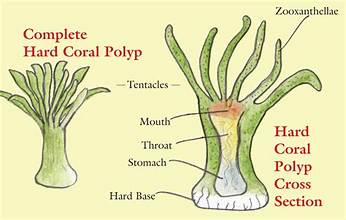
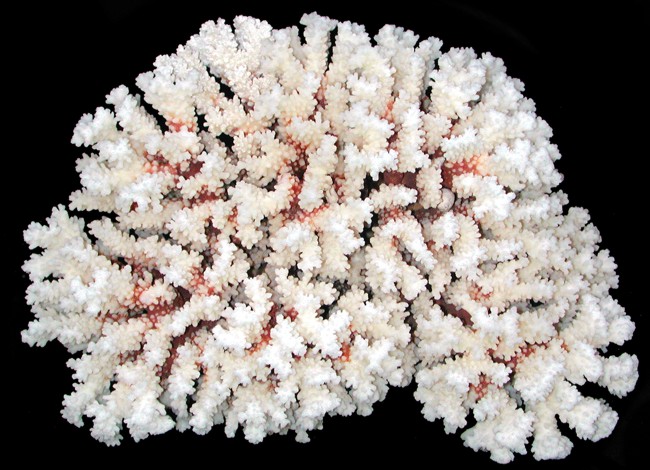
Pocillopora Verrucosa, common names brownstem, cauliflower coral, rasp coral, or knob-horned coral
This species belongs to the stony coral family Pocilloporidae. They are native to tropical and subtropical parts of the Indian and Pacific Oceans.
Pocillopora verrucosa is a colonial coral and grows into hemispherical clumps up to 30 cm (12 in) in diameter.[1] The branches are 1 to 2 cm (0.4 to 0.8 in) thick and usually have clubbed tips. The surface is covered with large verrucae (wart-like growths) up to 6 mm (0.24 in) high and the corallites (the stony cups from which the polyps emerge) are a fraction of an inch in diameter. The color of this coral varies and it may be yellowish-green, pink, brown or bluish-brown. It differs from Pocillopora damicornis in having broader, somewhat flattened, club-tipped branches and by the fact that its (verrucae a warty elevation on a plant or animal surface) are more evenly sized and spaced.
n biology, a colony is composed of two or more conspecific individuals living in close association with, or connected to, one another. This association is usually for mutual benefit such as stronger defense or the ability to attack bigger prey.
Pocillopora verrucosa is native to the tropical and subtropical parts of the Indian and Pacific Oceans. Its wide range extends from East Africa and the Red Sea to Japan, Indonesia, Australia, Hawaii, Easter Island and the western coast of Central America. They are found at depths down to about 177 feet but is most common between 3 to 49 feet. They are common in most of its range and are found on fringing reefs and moderately-exposed reef fronts but are less tolerant than P. damicornis of sediment and is therefore less common in lagoons.
Pocillopora verrucosa, like many corals, contains microscopic symbiotic dinoflagellate algae (zooxanthellae) living within their tissues. Through photosynthesis, these algae produce energy-rich molecules that the coral can assimilate. It has been found that these algae are already present in the eggs before spawning.
Pocillopora verrucosa can reproduce by fragmentation, a form of asexual reproduction. It is also a simultaneous hermaphrodite but its reproductive method varies across its range. Each polyp usually contains twelve gonads, the six nearest the mouth being ovaries and the other six spermaries. In South Africa the gametes are released simultaneously from both of these and spawning takes place at new moon in January (mid-summer) with the gametes being liberated into the water column. The Enewetak Atoll in the Marshall Islands, this species has been shown to fertilise the eggs internally and brood the developing planula larvae.
A number of predators feed on this coral. These include pufferfishes, parrotfishes and filefishes which feed on the tips of the branches and hermit crabs which scrape the skeletal tissue. Other animals feed on the soft tissues while leaving the skeleton intact including the butterflyfishes, the angelfishes and the damselfish, Stegastes acapulcoensis. Invertebrates which feed on this coral are the crown-of-thorns starfish (Acanthaster planci), Jenner's cowry (Jenneria pustulata), the sea urchin, Eucidaris galapagensis and the coral snails, Coralliophila spp.. Both the starfish and the cowry can kill a mature coral colony by stripping off the living tissue.
In general coral reefs around the world are being destroyed and although this coral is common and relatively resilient, it is likely that populations are in decline along with their habitat. The main threats are climate change, ocean acidification, bleaching and coral diseases. The IUCN has listed Pocillopora verrucosa as being of "Least Concern" as it considers that the rate of decline in its populations is not sufficient to justify listing it in a more threatened category. Like all corals, it is listed on CITES Appendix II.
Scientific classification
Domain: Eukaryota
Kingdom: Animalia
Phylum: Cnidaria
Class: Hexacorallia
Order: Scleractinia
Family: Pocilloporidae
Genus: Pocillopora
Species: Pocillopora verrucosa
Binomial name: Pocillopora verrucosa
Ellis and Solander, 1786
(REF: Hoeksema, B.W.; Rogers, A.; Quibilan, M.C. (2014). "Pocillopora verrucosa". IUCN Red List of Threatened Species. 2014)(REF: van der Land, Jacob (2018). "Pocillopora verrucosa (Ellis & Solander, 1786)". WoRMS. World Register of Marine Species)(REF: Hirose, M.; Kinzie, R. A.; Hidaka, M. (2000). "Early development of zooxanthella-containing eggs of the corals Pocillopora verrucosa and P. eydouxi with special reference to the distribution of zooxanthellae". Biological Bulletin. 199)(REF: Kruger, A.; Schleyer, M. H. (1998). "Sexual reproduction in the coral Pocillopora verrucosa (Cnidaria: Scleractinia) in KwaZulu-Natal, South Africa". Marine Biology. 132)(REF: Sier, C. J. S.; Olive, P. J. W. (1994). "Reproduction and reproductive variability in the coral Pocillopora verrucosa from the Republic of Maldives". Marine Biology. 118)
Coral cluster shape can vary.
CC2-100
A single Brownstem Coral cluster, measuring between 6 to 8 inches...... OUT OF STOCK
CC3-100
One Brownstem Coral cluster, measuring 8 to 10 inches. .... $44.25
CC4-100
A Brownstem Coral cluster measuring 10 to 12 inches. .....$67.75
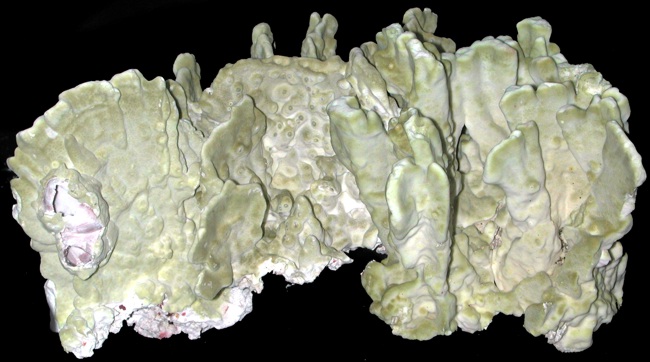
Millepora common name Fire Coral
Coral cluster shape can vary.
GFC1-100
One Green Fire Coral cluster measuring 5 to 8 inches..... OUT OF STOCK
GFC2-100
One Green Fire Coral Cluster measuring 8 to 10 inch ..... $63.25
GFC3-100
A Green Fire Coral cluster measuring at least 10 inches . ... $73.95
Fire Corals are a genus of colonial marine organisms that exhibit physical characteristics similar to that of coral. The name coral is somewhat misleading, as fire corals are not true corals but are instead more closely related to Hydra and other hydrozoans, making them hydrocorals. They make up the only genus in the monotypic family Milleporidae.
Fire coral derives its name from the intense burning sensation one gets when you touch or brush up against it. Fire coral, like all coral, falls into the animal kingdom. Many people think of coral as plants or sometimes mineral formations but they are part of the Kingdom Animalia.
The polyps of fire corals are near microscopic size and are mostly embedded in the skeleton and connected by a network of minute canals. All that is visible on the smooth surface are pores of two sizes: gastropores and dactylopores. Millepora means thousand pores. Dactylozooids have long fine hairs that protrude from the skeleton. The hairs possess clusters of stinging cells and capture prey, which is then engulfed by gastrozooids, or feeding polyps, situated within the gastropores. As well as capturing prey, fire corals gain nutrients via their special symbiotic relationship with algae known as zooxanthellae. The zooxanthellae live inside the tissues of the coral, and provide the coral with food, which they produce through photosynthesis, so require sunlight. In return, the coral provides the algae with protection and access to sunlight. The hollow tubes in fire coral can also be used to store oxygen to offset any organism that bumps into it.
There are different types of spores on the surface of the fire coral one type is called dactylopores. The dactylopores have long fine hairs that protrude from the skeleton. The hairs possess clusters of stinging cells (nematocysts). These hairs capture prey, which is then engulfed by gastrozooids, or feeding polyps, situated within the gastropores (the other type of pores found in fire coral). The fine hairs protruding from the dactylopores also inflict the stings on human skin.
When capturing prey, fire corals gain nutrients through a symbiotic relationship with algae known as zooxanthellae. The zooxanthellae live under the clear skin of fire coral, and provide the coral with food, which they produce through photosynthesis. The coral then provides the algae with protection and access to sunlight which the zooxanthellae require for survival. The amount and type of algae will contribute to the color and appearance of the coral.
Reproduction in fire corals is more complex than in other reef-building corals. The polyps reproduce sexually, producing jellyfish-like medusae, which are released into the water from special cup-like structures known as ampullae. The medusae contain the reproductive organs that release eggs and sperm into the water. Fertilized eggs then develop into free-swimming larvae that will eventually settle on the substrate and form new colonies. Fragmentation of the main colony is another possible method of asexual reproduction, and most imported specimens arrive as pieces broken off a larger colony.
Fire corals are found on reefs in tropical and subtropical waters, such as the Indian Ocean, Pacific Ocean, and Atlantic Ocean and the Caribbean Sea. They are found in shallow reefs where the most amount of sunlight is able to reach them, allowing for a higher rate of photosynthesis of the algae that lives in their tissues. Fire corals thrive in an environment with a high, strong current, and warm water. They are found in almost all places in the world, except for cold coastal regions. They are also abundant on upper reef slopes and in lagoons, and occur down to 131 feet deep.
Reproduction in fire corals is more complex than in other reef-building corals. The polyp of fire coral releases a medusa that releases its eggs in the water stream. Then another male medusa fertilizes the eggs with its sperm, which then produces a planula. A planula then floats in the water under it finds a reef it is able to attach to and grow back into a polyp, settling on a hard surface. Then the cycle repeats.
Fire corals are sessile (fixed in one place) creatures that can attach to rocks, coral, seaweed, pilings, artificial reefs or man-made structures. Their shape can vary. Most common types are either branching or blade shaped coral, however, fire coral can encrust many existing structures like dead coral, rocks, moorings, pilings, ship wrecks or other objects found underwater. These encrusting forms of fire coral can take on the shape of whatever object they are covering.
While most fire corals are yellow or orange, they can also be found in shades of brown, green, and even blue, providing a vibrant display underwater. The types of fire coral found in the Atlantic Ocean, Caribbean Sea and Gulf of Mexico are a mustard yellow to light tan color with white tips. They usually appear to have a smooth satin-like surface on which they tend to produce very fine hair-like structures that create a fuzzy look to the surface. These are the structures that can sting.
Fire corals face the many threats impacting coral reefs globally, including poor land management practices releasing more sediment, nutrients, and pollutants into the oceans and stressing the fragile reef ecosystem. Overfishing has effects that result in the increase of macroalgae that can outcompete and smother corals, and fishing using destructive methods physically devastates the reef. A further potential threat is the increase of coral bleaching events, as a result of global climate change.
Coral bleaching is a major threat to all types of coral. Coral bleaching is when the coral expels the zooxanthella that they feed on, which causes them to turn white, hence "bleaching." Corals can not live long in this state, yet if environmental conditions return to normal, then the zooxanthella can return and the coral will return healthy again.
Fire corals are listed on Appendix II of the Convention on International Trade in Endangered Species (CITES).
Scientific classification
Domain: Eukaryota
Kingdom: Animalia
Phylum: Cnidaria
Class: Hydrozoa
Order: Anthoathecata
Suborder: Capitata
Family: Milleporidae
Fleming, 1828
Genus: Millepora
Linnaeus, 1758
(REF: "Fire Coral". Lamar University. April 27, 2024.)(REF: Cornwell, Mureil (March 6, 2024). Smith, Sherman (ed.). "19 Fire Coral Facts". Facts.net)(REF: "The Fire Corals". Aquarium Net. October 1996. Archived from the original on 2008-02-06)(REF: What is Coral Bleaching and Why Should You Care?". Coral Reef Alliance. March 17, 2023)(REF: Kropp, M.L. Parsley B. C. Burnett, Lee Omer. (2018). Millepora species(Fire Coral) Sting: A Case Reportand Review of Recommended Management'. Vol. 29)(REF: Fire Coral". Reef Smart Guides.)(REF: Wilkinson, C. (2004) Status of Coral Reefs around the Word. Australian Institute of Marine Science, Townsville, Australia)(REF: CITES: Appendices I, II and III Archived November 16, 2008, at the Wayback Machine)(REF: "WoRMS - World Register of Marine Species - Millepora Linnaeus, 1758)
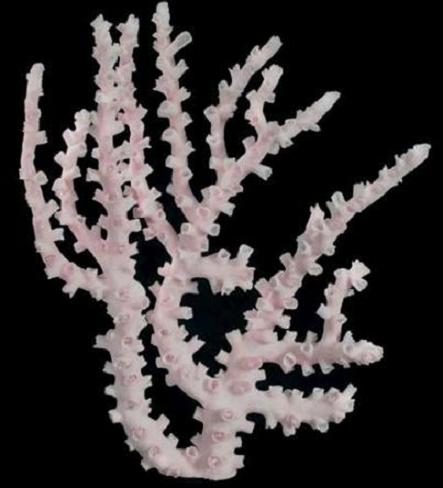
Galaxea fascicularis
These are a species of colonial stony coral in the family Euphylliidae, commonly known as Octopus coral, Fluorescence grass coral, and Galaxy coral among various vernacular names.
Small colonies of Galaxea fascicularis often form low domes but as they grow, the colonies become more irregular, massively hummocky or columnar and may eventually reach 16 feet across. The corals are the calcareous skeletons of polyps and the variability in shape is at least partly caused by the activities of horse mussels which bore into the skeletons. The individual polyps are embedded in circular, tube-shaped corallites less than 1/2 inch across, made of a limy material extruded by the polyps. Lining the corallites are a large number of ridge-like septa radiating from the center. The polyps often feed in the daytime, and when their tentacles are extended the basic skeleton of the coral is hidden. The general color of the coral ranges from green and grey to reddish brown. The tentacles are often a contrasting color and are usually tipped with white. A few of the tentacles are modified into sweeper tentacles which can be extended to 12 inches in length and serve to deter other organisms from settling close by.
The size and proximity of the corallites varies depending on the amount of light incident on the coral, even over different areas of the same colony. In bright positions, small, closely packed corallites maximize the photosynthetic potential of the zooxanthellae. In less well lit positions, there are larger corallites and polyps with longer tentacles with greater food capturing ability.
Galaxea fascicularis are found in the Red Sea, the Gulf of Aden and in large areas of the Indo-Pacific. They dwell on coral reef slopes, particularly where the wave action is weak. Its depth range is between 6 to 49 feet.
Galaxea fascicularis gets its food from two sources. The polyps contain symbiotic photosynthetic microalgae called zooxanthellae which, under good conditions, can obtain almost sufficient energy from sunlight for the coral's needs. It is also heterotrophic; the polyps extend their tentacles and catch and ingest organic particles, sediment, zooplankton, bacteria and even dissolved organic matter. This supplies the rest of the coral's needs.
Galaxea fascicularis can reproduce asexually by budding. They also reproduces sexually, with both sperm and eggs being released into the water table in synchronized spawning for external fertilization. The planula larvae that develop from the eggs drift as part of the zooplankton. After heavy attrition by predation, the few that survive settle on the seabed, undergo metamorphosis and develop into a polyp. This starts extruding a skeleton, budding and growing into a new colony.
In common with other corals that contain zooxanthella, Galaxea fascicularis are likely to be stressed by climate change and the warmer waters it may cause. Adverse effects of a rise in sea temperature may be more severe storms, a greater incidence of the El Niño-Southern Oscillation and more frequent outbreaks of coral disease. Higher water temperatures tend to kill the symbiotic microalgae causing bleaching of the coral. Without their symbionts, the coral fails to thrive and the polyps may die. Compared to some other reef corals, this species is relatively resistant to bleaching and to being buried by increased sedimentation.
symbionts an individual living in symbiosis especially : the smaller member of a symbiotic pair
symbiosis refers to interaction between two different organisms living in close physical association, typically to the advantage of both.
Galaxea fascicularis are a common species that takes about 8 years to reach maturity, making it difficult to assess its survival status except over long time scales. They are popular in the aquarium trade. In 2005, Indonesia exported 17,550 live pieces and Fiji and other countries exported lesser amounts. Other threats to this species include trawling and consequent reef destruction, pollution and tourism.
Octopus coral are widely available for use in reef aquaria. They have a fragile skeleton and should be handled carefully. The temperature in the tank needs to be maintained between 74° and 81 °F. The coral needs to be in a well lit area with a low or moderate water flow. They should not be placed within 12 inches of any other coral or sessile invertebrate because they use its sweeper tentacles to sting intruders and defend their territory. Cultivated corals can be propagated by sawing the skeleton into lengths and suspending the pieces on threads.
Scientific classification
Domain: Eukaryota
Kingdom: Animalia
Phylum: Cnidaria
Class: Hexacorallia
Order: Scleractinia
Family: Euphylliidae
Genus: Galaxea
Species: Galaxea fascicularis
Binomial name: Galaxea fascicularis
(Linnaeus, 1767)
(REF: Galaxea fascicularis IUCN 2011. IUCN Red List of Threatened Species)(REF: WoRMS (2010). "Galaxea fascicularis (Linnaeus, 1767)". WoRMS. World Register of Marine Species.)(REF: Galaxy coral Animal-World. Retrieved 2011)(REF: Galaxea fascicularis Corals of the World online. Retrieved 2011)(REF: Crabbe, M. James C.; David J. Smith (2006). "Modelling variations in corallite morphology of Galaxea fascicularis coral colonies with depth and light on coastal fringing reefs in the Wakatobi Marine National Park (S.E. Sulawesi, Indonesia)" (PDF). Computational Biology and Chemistry. 30 (2): 155–159. doi:10.1016/j.compbiolchem.2005)(REF: Fluorescence grass coral (Galaxea fascicularis) Archived 2011-12-11 at the Wayback Machine ARKive. Retrieved 2011)(REF: Marshall, P.A., Baird, A.H., 2000. Bleaching of corals on the Great Barrier Reef: differential susceptibilities among taxa. Coral Reefs 19)(REF: Philipp, E., Fabricius, K., 2003. Photophysiological stress in scleractinian corals in response to short-term sedimentation. J. Exp. Mar. Biol. Ecol. 287)
The Octopus Coral branch shape can vary
0C1-100
One 10 to 12 inch Octopus Coral..... OUT OF STOCK
OC2-100
One 12 to 15 inch Octopus Coral..... OUT OF STOCK
OC3-100
One 15 to 17 inch Octopus Coral 15 to 17..... OUT OF STOCK
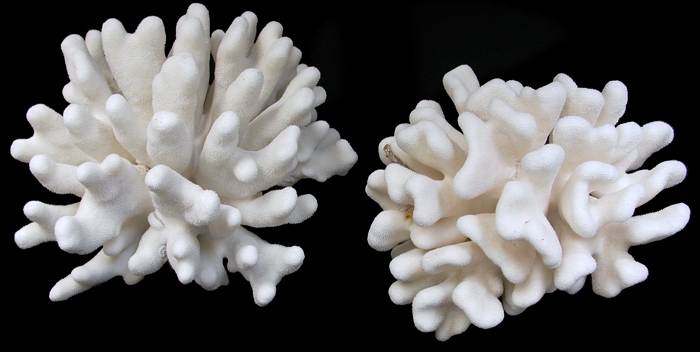
Acropora Palmata
common name Elkhorn coralElkhorn coral is an important reef-building coral in the Caribbean. The species has a complex structure with many branches which resemble that of elk antlers; hence, the common name. The branching structure creates habitat and shelter for many other reef species. Elkhorn coral is known to grow quickly with an average growth rate of 2.0 to 4 inches per year. They can reproduce both sexually and asexually, though asexual reproduction is much more common and occurs through a process called fragmentation.
Fragmentation in multicellular or colonial organisms is a form of asexual reproduction or cloning, where an organism is split into fragments upon maturation and the separated part becomes the new individual.
Although Elkhorn coral dominated the Caribbean in the early 1980s, the species has since dramatically declined in numbers. Scientists have estimated that between 1980 and 2006, when it was listed in the Endangered Species Act (ESA), the population declined by around 97%. This decline was due to a variety of factors, including disease, algae growth, climate change, ocean acidification, and human activity. In May 2006, Elkhorn coral was officially listed as threatened in the ESA along with another species in the Acropora genus, staghorn coral. Some conservation efforts are now in place to protect the species and promote increased genetic variability among the species.
Ocean acidification is the ongoing decrease in the pH of the Earth's ocean. Over the past 200 years, the rapid increase in anthropogenic CO2 (carbon dioxide) production has led to an increase in the acidity of the Earth’s oceans. Between 1950 and 2020, the average pH of the ocean surface fell from approximately 8.15 to 8.05.[2] Carbon dioxide emissions from human activities are the primary cause of ocean acidification, with atmospheric carbon dioxide (CO2) levels exceeding 410 ppm (in 2020). CO2 from the atmosphere is absorbed by the oceans. This chemical reaction produces carbonic acid (H2CO3) which dissociates into a bicarbonate ion (HCO−3) and a hydrogen ion (H+). The presence of free hydrogen ions (H+) lowers the pH of the ocean, increasing acidity (this does not mean that seawater is acidic yet; it is still alkaline, with a pH higher than 8). Marine calcifying organisms, such as mollusks and corals, are especially vulnerable because they rely on calcium carbonate to build shells and skeletons.
Elkhorn coral produce hard antler-like structures composed of calcium carbonate. These structures can be up to 6 feet high and 43 feet wide. Healthy Elkhorn coral are a dull, brownish-yellow color.
Elkhorn coral's primary source of food comes from photosynthetic algae, zooxanthellae, that live inside the coral's cells.[4] Therefore, Elkhorn coral are highly dependent on the sunlight for sustenance, leaving Elkhorn coral vulnerable to increased turbidity or water clarity. During bleaching events, or long-term periods of increased turbidity, Elkhorn coral can obtain nourishment from alternative food sources through filter feeding.
Zooxanthellae are photosynthetic organisms, which contain chlorophyll a and chlorophyll c, as well as the dinoflagellate pigments peridinin and diadinoxanthin. These provide the yellowish and brownish colours typical of many of the host species. During the day, they provide their host with the organic carbon products of photosynthesis, sometimes providing up to 90% of their host's energy needs for metabolism, growth and reproduction. In return, they receive nutrients, carbon dioxide, and an elevated position with access to sunshine.
Elkhorn coral have special algae living in their tissues known as zooxanthellae. Zoothanthellae meet their nutritional requirements using photosynthesis, a process that converts carbon dioxide and water into sugars and oxygen. Elkhorn coral provide habitat for these algae and, in turn, receive an abundant source of oxygen, enabling them to grow quickly.
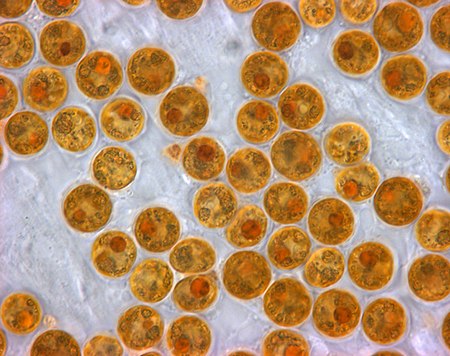
Brownish-Yellow Zooxanthellae image
Elkhorn coral's primary source of nutrients comes from photosynthetic algae, zooxanthellae, that live inside the coral's cells.Therefore, Elkhorn coral are highly dependent on the sunlight for sustenance, leaving Elkhorn coral vulnerable to increased turbidity or water clarity. During bleaching events, or long-term periods of increased turbidity, Elkhorn coral can obtain nourishment from alternative food sources through filter feeding.
Elkhorn coral can also use filter feeding techniques to obtain food. At night, Elkhorn coral use their tentacles to snatch free-swimming zooplankton from the water. Zooplankton complete daily diel migrations. In the morning, zooplankton sink to the depths of the ocean where predators are scarce, and then come nightfall, they rise back towards the surface. By concentrating their predation activities at night, Elkhorn coral expend less energy catching large amounts of prey. However, because filter feeding is more energy intensive than relying on zooxanthellae, Elkhorn coral will only resort to this feeding method when water conditions are poor and block out sunlight.
Elkhorn coral live in shallow habitats, which give them abundant access to light. Elkhorn coral requires oxygen to survive, most of which they obtain through special, photosynthetic algae living in their tissues called zooxanthellae. In order to help zooxanthellae produce as much oxygen as possible, Elkhorn coral live in shallow regions between 3 to 16 feet deep to ensure that abundant light reaches the zooxanthellae, maximizing photosynthesis.
Elkhorn corals are found in clear, shallow water throughout the Bahamas, Florida, the Caribbean, and beyond to the northern shores of Venezuela. Broward County Florida is the most north point they have been found. Elkhorn coral thrive best in high-energy zones where wave action is frequent; which increases the likely hood of fragmentation, resulting in more new colonies to form.
Due to fragmentation and rapid growth rates, Elkhorn coral were the primary foundation in the development of the Caribbean coral reefs. Over the last 5,000 years, Elkhorn coral, Staghorn coral, and Star coral comprised the southeastern reefs. Research has shown that the Elkhorn coral evolved during the Mid-Pliocene epoch, 5.2-2.58 million years ago. The unstable climate during this period allowed Elkhorn coral to thrive during glacial and interglacial events. During glacial events, sea levels rise and cause an increase in wave energy. As previously mentioned, Elkhorn coral does best in environments that are shallow and experience high energy changes, which aid in the reproductive process.
Resembling the foundation of a house, Elkhorn coral support coral reef communities. Their interwoven lattice-like branches create a variety of habitats varying in topography, which in turn, support diverse fish populations. These habitats support fish nurseries and protect fish from predators, increasing reef diversity. This elevated diversity makes the reefs more appealing to tourists, thereby increasing their economic value.
Elkhorn coral create thick, interlocking groups known as thickets. Thickets provide shelter to other marine life such as fish, crustaceans, and marine invertebrates, and consist of many identical polyps that have grown together. These dense groups provide protection to shorelines against large waves and storms.
The Elkhorn coral is a simultaneous hermaphrodite, meaning that in each coral colony both egg and sperm are produced. Despite this, self-fertilization usually does not occur. In order for successful fertilization to take place, two genetically distinct parents are needed. Successful reproduction rates are low in Elkhorn coral which limit the growth of new colonies. The probability of successful reproduction rates are low in Elkhorn coral because only about 50% of Elkhorn corals are genetically unique individuals. The Elkhorn coral reproduction cycle occurs once per year, after a full moon in the late summer, during the months of either July, August, or September. The gametes are released for only a few nights by broadcast spawning eggs and sperm into a water column. Once fertilized, the eggs develop into larvae that settle on hard surfaces and begin the growth of a new colony. Elkhorn coral colonies live for centuries. These coloni grow between 2 to 4 inches each year, reaching maximum size in 10 to 12 years.
Elkhorn coral are threatened by climate change. Climate change refers to the general warming of earth's average temperature caused by carbon emissions. Warmer atmospheric temperatures incidentally also increase water temperature. Elkhorn coral have special algae called zooxanthellae, living on their tissues, which provide many benefits. When water temperatures warm, Elkhorn coral expel their zooxanthellae. Without their zooxanthellae, Elkhorn coral first lose their prime oxygen source, then color, and then usually die. Climate change increases the severity and prevalence of storms, which can decimate Elkhorn coral populations. Elkhorn coral are currently listed as critically endangered.
Scientific classification
Domain: Eukaryota
Kingdom: Animalia
Phylum: Cnidaria
Class: Hexacorallia
Order: Scleractinia
Family: Acroporidae
Genus: Acropora
Species: Acropora palmata
Binomial name: Acropora palmata
Lamarck, 1816
(REF: Aronson, R.; Bruckner, A.; Moore, J.; Precht, B.; E. Weil. (2008). "Acropora palmata". IUCN Red List of Threatened Species. 2008:)(REF: WoRMS (2010). "Acropora palmata (Lamarck, 1816)". WoRMS. World Register of Marine Species. Retrieved December2011.)(REF: Crabtree, R. E (2014). Endangered Species Act - Section 7 Consultation Biological Opinion. United States Corps of Engineers)(REF: Fisheries, NOAA (December 30, 2019). "Elkhorn Coral | NOAA Fisheries". NOAA. Retrieved April 2020)(REF: "Welcome to the NOAA Institutional Repository |". repository.library.noaa.gov. Retrieved April 14, 2020.)(REF: "Endangered and Threatened Species; Critical Habitat for Threatened Elkhorn and Staghorn Corals". Federal Register. November 2008. Retrieved April 2020)(REF: Ferrario, Filippo; Beck, Michael W.; Storlazzi, Curt D.; Micheli, Fiorenza; Shepard, Christine C.; Airoldi, Laura (May 13, 2014). "The effectiveness of coral reefs for coastal hazard risk reduction and adaptation". Nature Communications. 5)(REF: Fisheries, NOAA (December 2019). "Critical Habitat for Elkhorn and Staghorn Corals | NOAA Fisheries". NOAA. Retrieved April 2020.)(REF: Hernandez-Delgado (January 2010). "Sediment Stress, Water Turbidity, and Sewage Impacts on Threatened Elkhorn Coral (Acropora palmata) Stands at Vega Baja, Puerto Rico". Proceedings of the 63rd Gulf and Caribbean Fisheries Institute. 63)(REF: "Endangered and Threatened Species; Availability of the Final Recovery Plan for Staghorn and Elkhorn Corals". Federal Register. March 2015. Retrieved April 2020.)(REF: NOAA Fisheries Species Directory - Elkhorn Coral (Acropora palmata)
Coral Clusters can vary in shape.
ELK1-100
A single Elkhorn Coral branch measuring 5 to 7 inches.....OUT OF STOCK
ELK2-100
An Elkhorn Coral branch, measuring between 7 to 9 inches.....OUT OF STOCK
ELK3-100
One 9 to 11 inch Elkhorn Coral branch.....OUT OF STOCK
ELK4-100
An Elkhorn Coral cluster measuring 11 to 13 inches......OUT OF STOCK
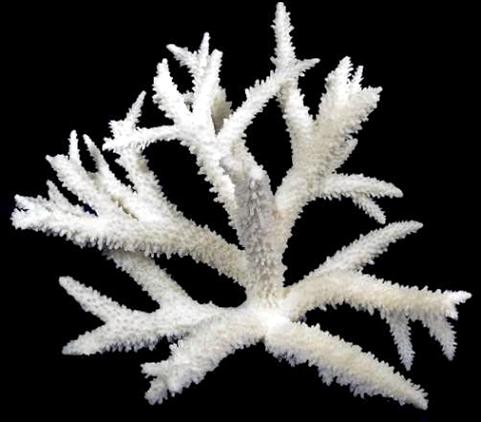
Acropora cervicornis common name Staghorn coral
Stag Horn Coral branch shape can vary
SH1-100
One Staghorn Coral cluster measuring 7 to 10 inches .....$52.25
SH2-100
A single Staghorn Coral branch measuring 10 to 12 inches.......$65
1SH3-100
A Staghorn Coral cluster measuring 12 to 14 inches. .....$108.25
Staghorn coral is a branching, stony coral, within the Order Scleractinia. It is characterized by thick, upright branches which can grow in excess of 6 feet in height and resemble the antlers of a stag, hence the name, Staghorn. This coral grows within various areas of a reef but is most commonly found within shallow fore and back reefs, as well as patch reefs, where water depths rarely exceed 65 feet. Staghorn corals can grow rapidly, adding up to 2 inches in new skeleton annually, making them one of the fastest growing fringe coral species in the Western Atlantic. Due to this fast growth, Acropora cervicornis, serve as one of the most important reef building corals, functioning as marine nurseries for juvenile fish, buffer zones for erosion and storms, and center points of biodiversity in the Western Atlantic.
Up until the late 1970s, much of the (fore front, forward, earlier) reef zones within the Atlantic around the coasts of Southern Florida and the Caribbean Islands were covered with vast, dense colonies of Staghorn coral consisting largely of single-species stands; however, a combination of white-band disease and various anthropogenic factors have reduced this coral coverage by over 95% in some areas.
As of 2006, Staghorn coral is listed as Critically Endangered under the International Union for Conservation of Nature and are federally designated as a threatened species under the Endangered Species Act of 1973.
Staghorn coral is found throughout the Western Atlantic, from the Florida Keys and the Bahamas, to the coasts of the various Caribbean islands. It dwells in the western Gulf of Mexico, as well as Bermuda and the west coast of South America; the northern limit of this species is Palm Beach County, Florida, where only small populations have been found.
Staghorn coral is most commonly found to depths of 65 feet in clear, non-turbid environments consistent with fore, back and patch reefs in the Western Atlantic Ocean. In this environment, water temperatures typically range between 66 to 80 degrees Fahrenheit with salinity ranging from 33 to 37 ppt (parts per thousand).
Salinity is the saltiness or amount of salt dissolved in a body of water, called saline water.
The skeleton of the Staghorn coral is made up of a specific type of calcium carbonate known as aragonite. This substance is secreted slowly by specialized calicoblastic cells, positioned in the layer directly above the coral skeleton. Over time, these calcium carbonate secretions build on one another, eventually creating large aragonite coral structures and the foundations of the world's coral reefs.
Aragonite is a carbonate mineral and one of the three most common naturally occurring crystal forms of calcium carbonate (Ca CO3), the others being calcite and vaterite. It is formed by biological and physical processes, including precipitation from marine and freshwater environments.
The Staghorn coral typically grows large, thick stems called branches, which can range anywhere from 1 to 3 inches in width. These branches grow in close proximity to one another, and sometimes resemble the antlers of a stag, hence its common name, Staghorn. A fully grown and healthy colony could have potential hundreds of these branches, and achieve sizes up to and exceeding 6 1/2 feet in both height and width.
The color of stony corals is largely dependent on the symbiotic zooxanthellae that lives within the corals tissue, and varies widely depending on the species and environment in which it lives. When it comes to the Staghorn coral specifically, tissue color can vary from light brown and beige to green, blue or purple.
Throughout millions of years of evolution, stony corals have formed a symbiotic relationship with 8 phylogenetic clades of dinoflagellate algae within the genus of Symbiodinium (also known as zooxanthellae). This symbiotic relationship has resulted in the incorporation of specialized dinoflagellates into the tissue of various coral species, including those of the Acropora genus like Acropora cervicornis (Staghorn coral).
Symbiotic means involving two types of animal or plant that depend on each other for survival.
Over time, these dinoflagellates have lost their flagella and become immobile and dependent on the coral as a host for safety and a source of carbon dioxide. At the same time, the coral has become dependent on the dinoflagellates for up to 90% of their total nutritional requirements, which includes various lipids, amino acids, and sugars as well as a source of oxygenation and waste removal. To fulfill the needs of the coral host, the zooxanthellae have become extremely densely packed within the coral tissue, in some cases up to and exceeding 1 million individual cells per centimeter squared of coral area.
This relationship has allowed corals to exist in relatively nutrient poor environments for millions of years, as almost all nutrients are recycled with very little waste.
Like the vast majority of coral species, Staghorn coral are both autotrophic and heterotrophic, meaning they have two main methods of acquiring the nutrients needed to sustain their growth and continued survival.
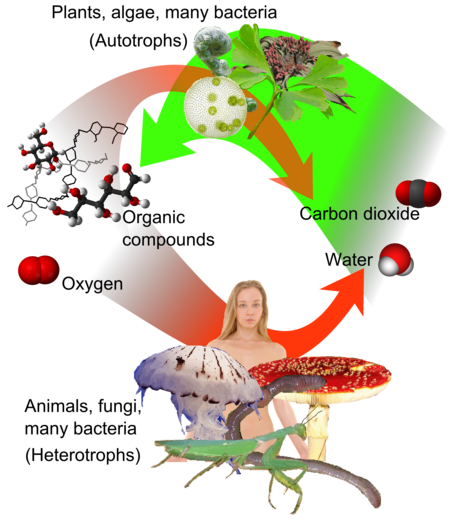
Image is an Overview of cycle between autotrophs and heterotrophs. Photosynthesis is the main means by which plants, algae and many bacteria produce organic compounds and oxygen from carbon dioxide and water (green arrow).
The first and most important method is autotrophic and comes from the photosynthetic symbiotic zooxanthellae that inhabit the tissue of the Staghorn. This method accounts for up to 90% of their total nutritional requirements.
The second method is heterotrophic and involves the ingestion of organisms from the polyp itself, where each individual polyp within the colony is capable of heterotrophy. This is the most common during night when photosynthesis is restricted and micro-organisms like zooplankton are feeding. Using their long feeding tentacles, polyps are able to catch passing food, stunning it with their stinging nematocysts to prevent escape, eventually orientating it towards the mouth at the center for digestion.
The contribution of nutrients gained from heterotrophy is poorly understood, however, it is thought that in stony corals, of which Staghorn is one, that it may account for anywhere from 0 to 66% of carbon fixation.
There are two methods by which Staghorn corals can produce, asexually and sexually.
Asexual reproduction most typically involves budding and fragmentation.
Budding is the process by which a single coral colony grows, and consists of two types of polyp budding. The first, known as intra-tentacular budding, is the formation of new polyps from the internal splitting of existing ones. The second, called extra-tentacular budding, is the formation of new polyps from tissue where none already exist, this includes the space around or between existing polyps. Budding produces genetically identical polyps to the ones that currently exist in the colony, meaning that all polyps in a colony are clones of each other.
Fragmentation is the process by which an entire coral colony gives rise to one or more new ones. This involves the breaking off of branches from existing Staghorn coral colonies and their subsequent implantation and growth on nearby substrates. In Staghorn corals, much like other stony corals, this appears to be the most common mode of reproduction and can result in a single coral giving rise to many new colonies, or sometimes entirely new coral reefs. Fragmentation can occur at anytime, and is usually the result of turbid flow from storms, nearby ships, dredging, or any disturbances in the water which would cause the breakage and successive replantation of coral branches.
Due to the nature of fragmentation, all new colonies are genetic clones of the original which can result in entire reefs of Staghorn coral being genetically identical, potentially rendering them more susceptible to disease or bleaching.
Like the majority of stony coral species within the genus Acropora, Staghorn coral is a simultaneous hermaphrodite, meaning it produces both female and male gametes within each individual polyp. Although they technically have the ability to self-fertilize, research suggests that single colonies are either completely or partially self-sterile, therefore, for successful reproduction of coral planula, two distinct colonies or parents are needed.
A gamete is a mature sex cell that has half of the normal number of chromosomes and can fuse with another gamete to form a new individual.
Release of eggs and sperm are synchronized in a single event called broadcasting. This increases the success of fertilization and production of fertile offspring. Staghorn coral spawning is typically restricted to late summer, in the months of July and August and occurs several days following a full moon. The mechanism by which these corals choose a spawn day is still unknown, however, it is almost certainly influenced by a multitude of factors including water temperature, the lunar cycle, wave action and tidal periods.
The method by which coral planula choose a spot on the reef to attach to is far more complex than previously thought. Instead of drifting through the water aimlessly and attaching at a random point, coral planula have developed various key adaptations to aid in their search for the perfect home. These include basic sensory abilities to avoid damaging UV radiation, as well as the ability to detect tides, water pressure, and even hear and smell environmental phenomena on nearby coral reefs. All of this together allows for the successful navigation of coral planula to nearby reefs, and the selection of a spot while avoiding harmful UV radiation, sedimentation and shading, giving the planula the best chance at survival.
Coral Planula are free-swimming or crawling larval type common in many species of the phylum Cnidaria (e.g., jellyfish, corals, and sea anemones). The planula body is more or less cylindrical or egg-shaped.
Overfishing is one of the biggest threats to coral reefs not only in the Caribbean and Western Atlantic where the Staghorn inhabits, but on many coral reefs around the world. The effects of overfishing are wide ranging, and can lead to an overgrowth of sponges (by as much as 25%) as their predators are systematically fished out and removed from the ecosystem. As sponges grow uninhibited, they outcompete, smother and prevent the settlement of coral planula as they become the dominant habitat forming organisms on the reef.
Bacterial infections also pose a great risk to Staghorn corals, as well as the closely related Elkhorn corals, both of which are essential reef building corals in the Western Atlantic and Caribbean, with white-band disease posing by far the greatest risk. This disease is host specific, meaning it only affects certain species of coral, the Staghorn among them. First observed in 1979, this disease is often credited with the massive population decline of shallow reef building corals, like the Staghorn and Elkhorn, contributing to as much as 95% of their decline. in the past 30 years.
Ocean temperature has increased by approximately 1.3°F from 1900 to 2019. This increase in temperature has accelerated over the past decade, resulting in approximately 4.5 times greater ocean warming than the previous 100 years. Ocean warming affects all marine species, perhaps none more than stony corals, like the Staghorn. Stony corals are extremely sensitive to temperature fluctuations and as ocean temperatures rise, corals become more susceptible to bleaching events. These events occur where the photosynthetic dinoflagellates (zooxanthellae) living symbiotically in the coral tissues are expelled, leaving the coral completely white and without its main nutrient source. In this state, coral is under its highest stress, and becomes more likely to contract disease, or starve, increasing its chance of mortality. If temperatures return to normal levels, the coral is able to reintegrate the zooxanthellae back into its tissues, however, as ocean warming events become more common, as a result of climate change, bleached corals are less likely to recover completely.
Staghorn coral is currently listed as critically endangered.
Scientific classification
Domain: Eukaryota
Kingdom: Animalia
Phylum: Cnidaria
Class: Hexacorallia
Order: Scleractinia
Family: Acroporidae
Genus: Acropora
Species: Acropora cervicornis
Binomial name: Acropora cervicornis
Lamarck, 1816
(REF: Richards, Z.T.; Miller, D.J.; Wallace, C.C. (2013). "Molecular phylogenetics of geographically restricted Acropora species: Implications for threatened species conservation". Molecular Phylogenetics and Evolution. 69)(REF: Aronson, R.; Bruckner, A.; Moore, J.; Precht, B. & E. Weil (2008). "Acropora cervicornis". IUCN Red List of Threatened Species. 2008)(REF: WoRMS (2010). "Acropora cervicornis (Lamarck, 1816)". WoRMS. World Register of Marine Species. Retrieved 2011)(REF:"Staghorn Coral". Aquarium of the Pacific. Retrieved 2024)(REF: Carpenter, Kent E.; Abrar, Muhammad; Aeby, Greta; Aronson, Richard B.; Banks, Stuart; Bruckner, Andrew; Chiriboga, Angel; Cortés, Jorge; Delbeek, J. Charles; DeVantier, Lyndon; Edgar, Graham J.; Edwards, Alasdair J.; Fenner, Douglas; Guzmán, Héctor M.; Hoeksema, Bert W. (2008-07-25). "One-Third of Reef-Building Corals Face Elevated Extinction Risk from Climate Change and Local Impacts". Science. 321)(REF: Lirman, Diego; Schopmeyer, Stephanie; Galvan, Victor; Drury, Crawford; Baker, Andrew C.; Baums, Iliana B. (2014-09-30). "Growth Dynamics of the Threatened Caribbean Staghorn Coral Acropora cervicornis: Influence of Host Genotype, Symbiont Identity, Colony Size, and Environmental Setting". PLOS ONE. 9)(REF: W., Bruckner, Andrew (2003). "Proceedings of the Caribbean Acropora Workshop : potential application of the U.S. Endangered Species Act as a conservation strategy, April 16-18, 2002, Miami, Florida". NOAA Technical Memorandum NMFS-OPR-24.)(REF: Ware, Matthew; Garfield, Eliza N.; Nedimyer, Ken; Levy, Jessica; Kaufman, Les; Precht, William; Winters, R. Scott; Miller, Steven L. (2020-05-06). "Survivorship and growth in staghorn coral (Acropora cervicornis) outplanting projects in the Florida Keys National Marine Sanctuary". PLOS ONE. 15)(REF: Carpenter, Kent E.; Abrar, Muhammad; Aeby, Greta; Aronson, Richard B.; Banks, Stuart; Bruckner, Andrew; Chiriboga, Angel; Cortés, Jorge; Delbeek, J. Charles; DeVantier, Lyndon; Edgar, Graham J.; Edwards, Alasdair J.; Fenner, Douglas; Guzmán, Héctor M.; Hoeksema, Bert W. (2008-07-25). "One-Third of Reef-Building Corals Face Elevated Extinction Risk from Climate Change and Local Impacts". Science. 321)(REF: A. Henry, Joseph; P. E. Yanong, Roy; P. McGuire, Maia; T. Patterson, Joshua (2020-09-06). "A GUIDE TO COMMON STONY CORALS OF FLORIDA". University of Florida. Retrieved 2024)(REF:ohnson, Cameron E.; Goulet, Tamar L. (2007-12-28). "A comparison of photographic analyses used to quantify zooxanthella density and pigment concentrations in Cnidarians". Journal of Experimental Marine Biology and Ecology. 353 )(REF: Berkelmans, Ray; van Oppen, Madeleine J.H (2006-09-22). "The role of zooxanthellae in the thermal tolerance of corals: a 'nugget of hope' for coral reefs in an era of climate change". Proceedings of the Royal Society B: Biological Sciences. 273)(REF: Muscatine, L.; W. Porter, James (1977). "Reef Corals: Mutualistic Symbioses Adapted to Nutrient-Poor Environments Get access Arrow". BioScience. 27)(REF: US Department of Commerce, National Oceanic and Atmospheric Administration. "Zooxanthellae...What's That - Corals: NOAA's National Ocean Service Education". oceanservice.noaa.gov. Retrieved 2024)(REF:Burmester, Elizabeth M.; Breef-Pilz, Adrienne; Lawrence, Nicholas F.; Kaufman, Les; Finnerty, John R.; Rotjan, Randi D. (2018-10-18). "The impact of autotrophic versus heterotrophic nutritional pathways on colony health and wound recovery in corals". Ecology and Evolution. 8)(REF:How do corals eat?". Florida Keys National Marine Sanctuary. Retrieved 2024-02-16. Harrison, Peter L. (2011), Dubinsky, Zvy; Stambler, Noga (eds.), "Sexual Reproduction of Scleractinian Corals", Coral Reefs: An Ecosystem in Transition, Dordrecht: Springer Netherlands, pp. 59–85, doi:10.1007/978-94-007-0114-4_6, ISBN 978-94-007-0114-4, retrieved 2024)(REF: Gignoux-Wolfsohn, S. A.; Marks, Christopher J.; Vollmer, Steven V. (2012-11-13). "White Band Disease transmission in the threatened coral, Acropora cervicornis". Scientific Reports. 2 )(REF: Garcia-Soto, Carlos; Cheng, Lijing; Caesar, Levke; Schmidtko, S.; Jewett, Elizabeth B.; Cheripka, Alicia; Rigor, Ignatius; Caballero, Ainhoa; Chiba, Sanae; Báez, Jose Carlos; Zielinski, Tymon; Abraham, John Patrick (2021). "An Overview of Ocean Climate Change Indicators: Sea Surface Temperature, Ocean Heat Content, Ocean pH, Dissolved Oxygen Concentration, Arctic Sea Ice Extent, Thickness and Volume, Sea Level and Strength of the AMOC (Atlantic Meridional Overturning Circulation)". Frontiers in Marine Science. 8.)(REF: "Endangered and Threatened Species; Critical Habitat for Threatened Elkhorn and Staghorn Corals". Federal Register. Retrieved 2024)
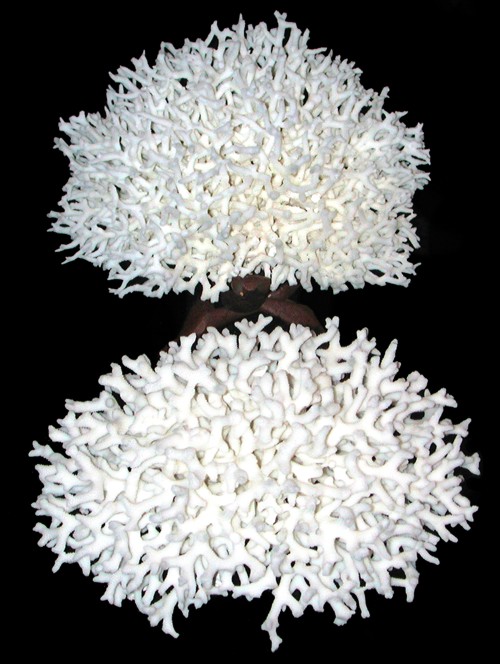
Seriatopora hystrix common name Birdnest Coral
Bird nest Coral clusters can vary in shape.
BN1-100
One 5 to 7 inch Bird nest Coral cluster ..... OUT OF STOCK
BN2-100
Bird's Nest Coral cluster measuring 7 to 9 inches ..... $55.25
BN3-100
A Bird nest Coral cluster measuring 9 to 11 inches ..... $70.90
BN4-100
One Bird nest Coral cluster measuring at least 11 inches ......$92
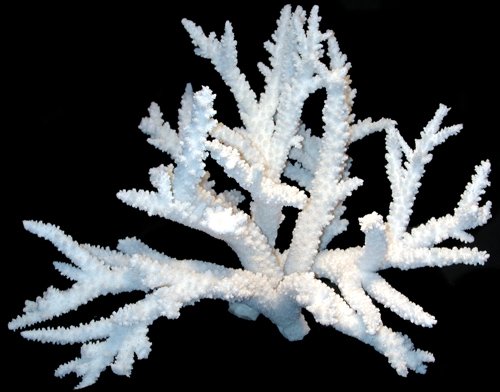
Acropora florida common name Branch Coral
Coral shapes can vary
BC1-100
A Branch Coral cluster measuring 7 to 10 inches. ....OUT OF STOCK
BC2-100
One Branch Coral cluster measuring 10 to 12 inches ....OUT OF STOCK
BC3-100
A Branch Coral cluster measuring 12 to 15 inches ..... $122.85
Acropora florida is a species of acroporid coral found in the southwest and northern Indian Ocean, the central Indo-Pacific, Australia, Southeast Asia, Japan and the East China Sea, Cook Islands and the oceanic west Pacific Ocean. It can be found in shallow reefs on the reef tops, walls and slopes to depths of 99 feet.
Acroporid Coral is a family of small polyped stony corals in the phylum Cnidaria. The name is derived from the Greek "akron" meaning "summit" and refers to the presence of a corallite at the tip of each branch of coral.
corallite is the skeletal cup, formed by an individual stony coral polyp, in which the polyp sits and into which it can retract. The cup is composed of aragonite, a crystalline form of calcium carbonate, and is secreted by the polyp. Corallites vary in size, but in most colonial corals they are less than an inch in diameter.
Colonies of Acropora florida consist of thick upright, and sometimes horizontal, branches growing from a sprawling or encrusting base. There are side branches and small branchlets which resemble knobs. The corallites are evenly spread. The color of this coral varies, and may be pinkish-brown or some shade of green.
Acropora florida is a zooxanthellate species of coral. It obtains most of its nutritional needs from the symbiotic dinoflagellates that live inside its soft tissues. These photosynthetic organisms provide the coral with organic carbon and nitrogen, sometimes providing up to 90% of their host's energy needs for metabolism and growth. Its remaining needs are met by the planktonic organisms caught by the tentacles of the polyps.
Zooxanthellae are photosynthetic organisms, which contain chlorophyll a and chlorophyll c, as well as the dinoflagellate pigments peridinin and diadinoxanthin. These provide the yellowish and brownish colors typical of many of the host species. During the day, they provide their host with the organic carbon products of photosynthesis, sometimes providing up to 90% of their host's energy needs for metabolism, growth and reproduction. In return, they receive nutrients, carbon dioxide, and an elevated position with access to sunshine.
This coral is a common species and no species-specific threats have been identified. The main threats faced by corals in general are related to climate change and the mechanical destruction of their coral reef habitats; increasing damage from extreme weather events, rising sea water temperatures and ocean acidification. The International Union for Conservation of Nature has assessed the conservation status of this species as being "near threatened". All corals receive protection by being listed on CITES Appendix II.
Scientific classification
Domain: Eukaryota
Kingdom: Animalia
Phylum: Cnidaria
Class: Hexacorallia
Order: Scleractinia
Family: Acroporidae
Genus: Acropora
Species: Acropora florida
Binomial name: Acropora florida
Dana, 1846
(REF: Richards, Z.T.; Delbeek, J.T.; Lovell, E.R.; Bass, D.; Aeby, G.; Reboton, C. (2014). "Acropora florida". IUCN Red List of Threatened Species. 2014)(REF: Hoeksema, Bert (2015). "Acropora florida (Dana, 1846)". WoRMS. World Register of Marine Species. Retrieved 8 August 2015)(REF: Ruppert, Edward E.; Fox, Richard, S.; Barnes, Robert D. (2004). Invertebrate Zoology (7th ed.). Cengage Learning.)(REF: Birkeland, Charles (1997). Life and Death of Coral Reefs. Springer Science & Business Media.)(REF:Michael D. Guiry; Robert A. Andersen (April 2018). "Validation of the generic name Symbiodinium (Dinophyceae, Suessiaceae) revisited and the reinstatement of Zooxanthella K.Brandt)(REF:Classification of Scleractinian (Stony) Corals". Archived from the original on 2011)(REF: Gómez F (2012). "A checklist and classification of living dinoflagellates (Dinoflagellata, Alveolata)". CICIMAR Oceánides. 27)
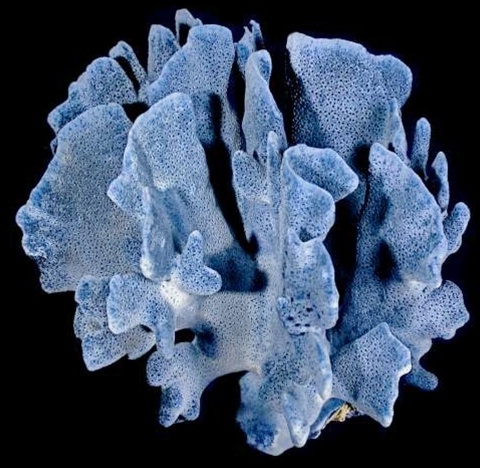
Blue Ridge Coral
Coral Cluster shape can vary. There will be some calcium deposit on base of coral, where it was attached.
BR1-100
A Blue Ridge Coral cluster in its natural color measuring 5 to 7 inches. ...... $48
BR2-100
A Blue Ridge Coral cluster measuring 7 to 10 inches. .... $59
BR3-100
A Blue Ridge Coral cluster measuring 10 to 12 inches.....$75
BR4-100
One 12 to 14 inch Blue Ridge Coral cluster.... $102
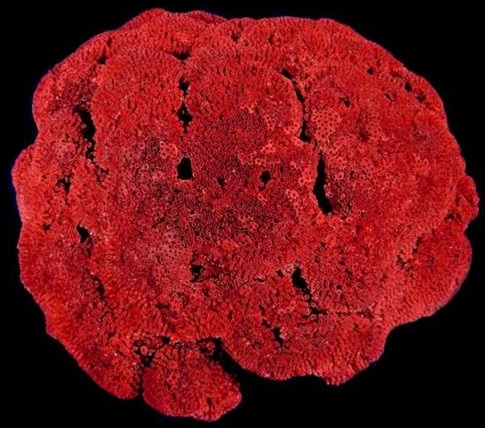
Red Pipe Organ Coral
Coral cluster shape will vary. There can be calcium deposits on the cluster base; where it was attached.
RP2-100
One Red Pipe Organ Coral 5 to 7 inches...OUT OF STOCK
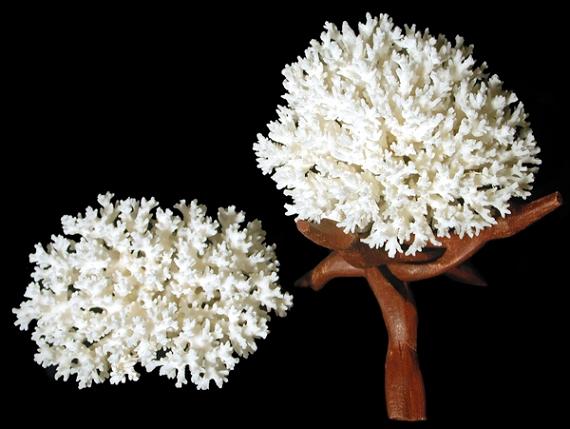
Lace Coral cluster
Coral Cluster shapes can vary.
LLC1-100
One Lace Coral cluster, measuring 5 to 7 inches..... OUT OF STOCK
LLC2-100
One Lace Coral cluster, measuring 7 to 9 inches..... $50
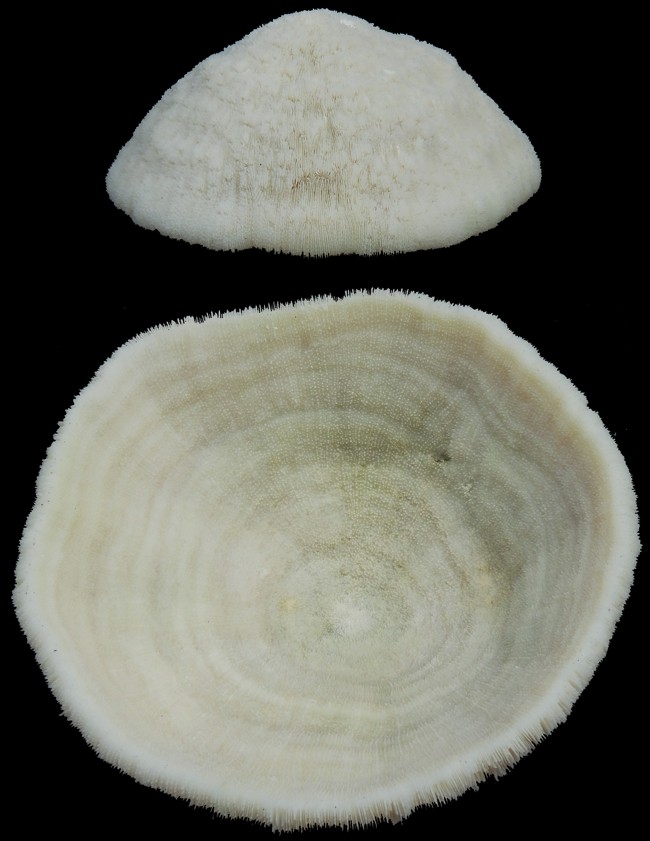
Bowl Coral cluster
Coral Cluster shapes can vary. Measured across bowl
MC4-1
One Bowl Coral Cluster, measuring 5 to 7 inches...... $44
MC5-1
One Bowl Coral Cluster measuring 7 to 9 Inches..... $73
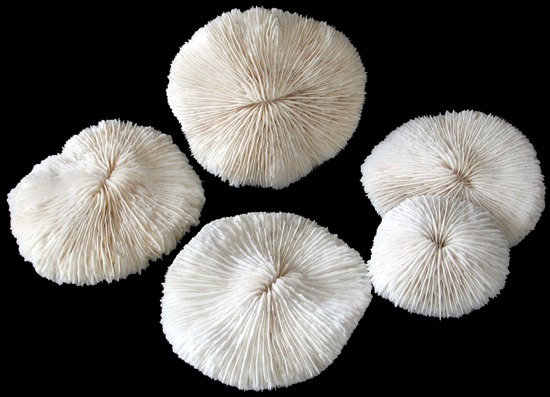
MUSHROOM CORAL
MC1-1
One Mushroom Coral piece 4 to 5 inches..... OUT OF STOCK
MC2-1
A Mushroom Coral cluster measuring 5 to 6 inches..... $20
coral reefs are underwater ecosystems characterized by reef-building corals. Reefs form from colonies of coral polyps held together by calcium carbonate. Most coral reefs are built from stony corals, whose polyps cluster in groups.
An ecosystem (or ecological system) is a system that environments and their organisms form through their interaction.[2]: 458 The biotic and abiotic components are linked together through nutrient cycles and energy flows.
Coral belongs to the class Anthozoa in the animal phylum Cnidaria, which includes sea anemones and jellyfish. Unlike sea anemones, corals secrete hard carbonate exoskeletons that support and protect the coral. Most reefs grow best in warm, shallow, clear, sunny and agitated water. Coral reefs first appeared 485 million years ago, at the dawn of the Early Ordovician, displacing the microbial and sponge reefs of the Cambrian.
Sometimes called rainforests of the sea, shallow coral reefs form some of Earth's most diverse ecosystems. They occupy less than 0.1% of the world's ocean area, about half the area of France, yet they provide a home for at least 25% of all marine species, including fish, mollusks, worms, crustaceans, echinoderms, sponges, tunicates and other cnidarians. Coral reefs flourish in ocean waters that provide few nutrients. They are most commonly found at shallow depths in tropical waters, but deep water and cold water coral reefs exist on smaller scales in other areas.
Shallow tropical coral reefs have declined by 50% since 1950, partly because they are sensitive to water conditions. They are under threat from excess nutrients (nitrogen and phosphorus), rising ocean heat content and acidification, overfishing (e.g., from blast fishing, cyanide fishing, spearfishing on scuba), sunscreen use, and harmful land-use practices, including runoff and seeps (e.g., from injection wells and cesspools).
Ocean acidification is the ongoing decrease in the pH of the Earth's ocean. Over the past 200 years, the rapid increase in anthropogenic CO2 (carbon dioxide) production has led to an increase in the acidity of the Earth’s oceans. Between 1950 and 2020, the average pH of the ocean surface fell from approximately 8.15 to 8.05. Carbon dioxide emissions from human activities are the primary cause of ocean acidification, with atmospheric carbon dioxide (CO2) levels exceeding 410 ppm (in 2020). CO2 from the atmosphere is absorbed by the oceans. This chemical reaction produces carbonic acid (H2CO3) which dissociates into a bicarbonate ion (HCO) and a hydrogen ion (H+). The presence of free hydrogen ions (H+) lowers the pH of the ocean, increasing acidity (this does not mean that seawater is acidic yet; it is still alkaline, with a pH higher than 8). Marine calcifying organisms, such as mollusks and corals, are especially vulnerable because they rely on calcium carbonate to build shells and skeletons.
Most coral reefs were formed after the Last Glacial Period when melting ice caused sea level to rise and flood continental shelves. Most coral reefs are less than 10,000 years old. As communities established themselves, the reefs grew upwards, pacing rising sea levels. Reefs that rose too slowly could become drowned, without sufficient light. Coral reefs are also found in the deep sea away from continental shelves, around oceanic islands and atolls. The majority of these islands are volcanic in origin. Others have tectonic origins where plate movements lifted the deep ocean floor.
In The Structure and Distribution of Coral Reefs, Charles Darwin set out his theory of the formation of atoll reefs, an idea he conceived during the voyage of the Beagle. He theorized that uplift and subsidence of Earth's crust under the oceans formed the atolls. Darwin set out a sequence of three stages in atoll formation. A fringing reef forms around an extinct volcanic island as the island and ocean floor subside. As the subsidence continues, the fringing reef becomes a barrier reef and ultimately an atoll reef.
Darwin predicted that underneath each lagoon would be a bedrock base, the remains of the original volcano. Subsequent research supported this hypothesis. Darwin's theory followed from his understanding that coral polyps thrive in the tropics where the water is agitated, but can only live within a limited depth range, starting just below low tide. Where the level of the underlying earth allows, the corals grow around the coast to form fringing reefs, and can eventually grow to become a barrier reef.
A lagoon is a shallow body of water separated from a larger body of water by a narrow landform, such as reefs, barrier islands, barrier peninsulas, or isthmuses. Lagoons are commonly divided into coastal lagoons (or barrier lagoons) and atoll lagoons. They have also been identified as occurring on mixed-sand and gravel coastlines. There is an overlap between bodies of water classified as coastal lagoons and bodies of water classified as estuaries. Lagoons are common coastal features around many parts of the world.
Where the bottom is rising, fringing reefs can grow around the coast, but coral raised above sea level dies. If the land subsides slowly, the fringing reefs keep pace by growing upwards on a base of older, dead coral, forming a barrier reef enclosing a lagoon between the reef and the land. A barrier reef can encircle an island, and once the island sinks below sea level a roughly circular atoll of growing coral continues to keep up with the sea level, forming a central lagoon. Barrier reefs and atolls do not usually form complete circles but are broken in places by storms. Like sea level rise, a rapidly subsiding bottom can overwhelm coral growth, killing the coral and the reef, due to what is called coral drowning. Corals that rely on zooxanthellae can die when the water becomes too deep for their symbionts to adequately photosynthesize, due to decreased light exposure.
Zooxanthellae are photosynthetic cells that live in coral tissues and provide them with nutrients and color.
The two main variables determining the geomorphology, or shape, of coral reefs are the nature of the substrate on which they rest, and the history of the change in sea level relative to that substrate.
The approximately 20,000-year-old Great Barrier Reef offers an example of how coral reefs formed on continental shelves. Sea level was then 120 m (390 ft) lower than in the 21st century. As sea level rose, the water and the corals encroached on what had been hills of the Australian coastal plain. By 13,000 years ago, sea level had risen to 200 feet lower than at present, and many hills of the coastal plains had become continental islands. As sea level rise continued, water topped most of the continental islands. The corals could then overgrow the hills, forming cays and reefs. Sea level on the Great Barrier Reef has not changed significantly in the last 6,000 years. The age of living reef structure is estimated to be between 6,000 and 8,000 years. Although the Great Barrier Reef formed along a continental shelf, and not around a volcanic island, Darwin's principles apply. Development stopped at the barrier reef stage, since Australia is not about to submerge. It formed the world's largest barrier reef, 980 to 3,280 ft) from shore, stretching for 1,200 miles.
Healthy tropical coral reefs grow horizontally from approximately 1/2 to nearly 1 1/20 inches per year, and grow vertically anywhere from approximately .25 to 9 3/4 inches per year; however, they grow only at depths shallower than 490 feet because of their need for sunlight, and cannot grow above sea level.
coral reefs are made up of coral skeletons from mostly intact coral colonies. As other chemical elements present in corals become incorporated into the calcium carbonate deposits, aragonite is formed. However, shell fragments and the remains of coralline algae such as the green-segmented genus Halimeda can add to the reef's ability to withstand damage from storms and other threats.
Spalding lists four main reef types that can be clearly illustrated – the fringing reef, barrier reef, atoll, and "bank or platform reef"—and notes that many other structures exist which do not conform easily to strict definitions, including the "patch reef".
A fringing reef, also called a shore reef, is directly attached to a shore, or borders it with an intervening narrow, shallow channel or lagoon.It is the most common reef type. Fringing reefs follow coastlines and can extend for many kilometres. They are usually less than 328 feet wide, but some are much wider. Fringing reefs are initially formed on the shore at the low water level and expand seawards as they grow in size. The final width depends on where the sea bed begins to drop steeply. The surface of the fringe reef generally remains at the same height: just below the waterline. In older fringing reefs, whose outer regions pushed far out into the sea, the inner part is deepened by erosion and eventually forms a lagoon. Fringing reef lagoons can become over 328 feet wide and several metres deep. Like the fringing reef itself, they run parallel to the coast. The fringing reefs of the Red Sea are "some of the best developed in the world" and occur along all its shores except off sandy bays.
Barrier reefs are separated from a mainland or island shore by a deep channel or lagoon. They resemble the later stages of a fringing reef with its lagoon but differ from the latter mainly in size and origin. Their lagoons can be several kilometres wide and 98 to 229 feet deep. Above all, the offshore outer reef edge formed in open water rather than next to a shoreline. Like an atoll, it is thought that these reefs are formed either as the seabed lowered or sea level rose. Formation takes considerably longer than for a fringing reef, thus barrier reefs are much rarer.
The best known and largest example of a barrier reef is the Australian Great Barrier Reef. Other major examples are the Mesoamerican Barrier Reef System and the New Caledonian Barrier Reef. Barrier reefs are also found on the coasts of Providencia, Mayotte, the Gambier Islands, on the southeast coast of Kalimantan, on parts of the coast of Sulawesi, southeastern New Guinea and the south coast of the Louisiade Archipelago.
Platform reefs, variously called bank or table reefs, can form on the continental shelf, as well as in the open ocean, in fact anywhere where the seabed rises close enough to the surface of the ocean to enable the growth of zooxanthemic, reef-forming corals. Platform reefs are found in the southern Great Barrier Reef, the Swain and Capricorn Group on the continental shelf, about 62 to 125 miles from the coast. Some platform reefs of the northern Mascarenes are more 700 miles from the mainland. Unlike fringing and barrier reefs which extend only seaward, platform reefs grow in all directions. They are variable in size, ranging from a few hundred feet to many miles across. Their usual shape is oval to elongated. Parts of these reefs can reach the surface and form sandbanks and small islands around which may form fringing reefs. A lagoon may form In the middle of a platform reef.
Platform reefs are typically situated within atolls, where they adopt the name "patch reefs" and often span a diameter of just a few dozen feet. In instances where platform reefs develop along elongated structures, such as old and weathered barrier reefs, they tend to arrange themselves in a linear formation. This is the case, for example, on the east coast of the Red Sea near Jeddah. In old platform reefs, the inner part can be so heavily eroded that it forms a pseudo-atoll. These can be distinguished from real atolls only by detailed investigation, possibly including core drilling. Some platform reefs of the Laccadives are U-shaped, due to wind and water flow.
Atolls or atoll reefs are a more or less circular or continuous barrier reef that extends all the way around a lagoon without a central island. They are usually formed from fringing reefs around volcanic islands. Over time, the island erodes away and sinks below sea level. Atolls may also be formed by the sinking of the seabed or rising of the sea level. A ring of reefs results, which enclose a lagoon. Atolls are numerous in the South Pacific, where they usually occur in mid-ocean, for example, in the Caroline Islands, the Cook Islands, French Polynesia, the Marshall Islands and Micronesia.
Atolls are found in the Indian Ocean, for example, in the Maldives, the Chagos Islands, the Seychelles and around Cocos Island. The entire Maldives consist of 26 atolls.
Coral reefs are estimated to cover about 109,800 sq miles, just under 0.1% of the oceans' surface area. The Indo-Pacific region (including the Red Sea, Indian Ocean, Southeast Asia and the Pacific) account for 91.9% of this total. Southeast Asia accounts for 32.3% of that figure, while the Pacific including Australia accounts for 40.8%. Atlantic and Caribbean coral reefs account for 7.6%.Corals exist both in temperate and tropical waters, shallow-water reefs form only in a zone extending from approximately 30° N to 30° S of the equator. Tropical corals do not grow at depths of over 160 feet. The optimum temperature for most coral reefs is 79 to 81 °F, and few reefs exist in waters below 64 °F. When the net production by reef building corals no longer keeps pace with relative sea level and the reef structure permanently drowns a Darwin Point is reached.
Reefs in the Persian Gulf have adapted to temperatures of 55 °F in winter and 100 °F in summer. 37 species of scleractinian corals inhabit such an environment around Larak Island.
Deep-water coral inhabits greater depths and colder temperatures at much higher latitudes, as far north as Norway. Although deep water corals can form reefs, little is known about them.
The northern most coral reef on Earth is located near Eilat, Israel. Coral reefs are rare along the west coasts of the Americas and Africa, due primarily to upwelling and strong cold coastal currents that reduce water temperatures in these areas (the Humboldt, Benguela, and Canary Currents, respectively). Corals are seldom found along the coastline of South Asia—from the eastern tip of India (Chennai) to the Bangladesh and Myanmar borders, as well as along the coasts of northeastern South America and Bangladesh, due to the freshwater release from the Amazon and Ganges Rivers respectively.
When alive, corals are colonies of small animals embedded in calcium carbonate shells. Coral heads consist of accumulations of individual animals called polyps, arranged in diverse shapes. Polyps are usually tiny, but they can range in size from a pinhead to 12 inches across.
Reef-building or hermatypic corals live only in the photic zone (above 229 feet), the depth to which sufficient sunlight penetrates the water.
Coral polyps do not photosynthesize, but have a symbiotic relationship with microscopic algae (dinoflagellates) of the genus Symbiodinium, commonly referred to as zooxanthellae. These organisms live within the polyps' tissues and provide organic nutrients that nourish the polyp in the form of glucose, glycerol and amino acids. Because of this relationship, coral reefs grow much faster in clear water, which admits more sunlight. Without their symbionts, coral growth would be too slow to form significant reef structures. Corals get up to 90% of their nutrients from their symbionts. In return, as an example of mutualism, the corals shelter the zooxanthellae, averaging one million for every cubic centimetre of coral, and provide a constant supply of the carbon dioxide they need for photosynthesis.
The varying pigments in different species of zooxanthellae give them an overall brown or golden-brown appearance and give brown corals their colors. Other pigments such as reds, blues, greens, etc. come from colored proteins made by the coral animals. Coral that loses a large fraction of its zooxanthellae becomes white (or sometimes pastel shades in corals that are pigmented with their own proteins) and is said to be bleached, a condition which, unless corrected, can kill the coral.
There are eight clades of Symbiodinium phylotypes. Most research has been conducted on clades A–D. Each clade contributes their own benefits as well as less compatible attributes to the survival of their coral hosts. Each photosynthetic organism has a specific level of sensitivity to photodamage to compounds needed for survival, such as proteins. Rates of regeneration and replication determine the organism's ability to survive. Phylotype A is found more in the shallow waters. It is able to produce mycosporine-like amino acids that are UV resistant, using a derivative of glycerin to absorb the UV radiation and allowing them to better adapt to warmer water temperatures. In the event of UV or thermal damage, if and when repair occurs, it will increase the likelihood of survival of the host and symbiont. This leads to the idea that, evolutionarily, clade A is more UV resistant and thermally resistant than the other clades.
Clades B and C are found more frequently in deeper water, which may explain their higher vulnerability to increased temperatures. Terrestrial plants that receive less sunlight because they are found in the undergrowth are analogous to clades B, C, and D. Since clades B through D are found at deeper depths, they require an elevated light absorption rate to be able to synthesize as much energy. With elevated absorption rates at UV wavelengths, these phylotypes are more prone to coral bleaching versus the shallow clade A.
Clade D has been observed to be high temperature-tolerant, and has a higher rate of survival than clades B and C during modern bleaching events.
Reefs grow as polyps and other organisms deposit calcium carbonate, the basis of coral, as a skeletal structure beneath and around themselves, pushing the coral head's top upwards and outwards. Waves, grazing fish (such as parrotfish), sea urchins, sponges and other forces and organisms act as bioeroders, breaking down coral skeletons into fragments that settle into spaces in the reef structure or form sandy bottoms in associated reef lagoons.
Typical shapes for coral species are named by their resemblance to terrestrial objects such as wrinkled brains, cabbages, table tops, antlers, wire strands and pillars. These shapes can depend on the life history of the coral, like light exposure and wave action, and events such as breakages.
Corals reproduce both sexually and asexually. An individual polyp uses both reproductive modes within its lifetime. Corals reproduce sexually by either internal or external fertilization. The reproductive cells are found on the mesenteries, membranes that radiate inward from the layer of tissue that lines the stomach cavity. Some mature adult corals are hermaphroditic; others are exclusively male or female. A few species change sex as they grow.
Internally fertilized eggs develop in the polyp for a period ranging from days to weeks. Subsequent development produces a tiny larva, known as a planula. Externally fertilized eggs develop during synchronized spawning. Polyps across a reef simultaneously release eggs and sperm into the water en masse. Spawn disperse over a large area. The timing of spawning depends on time of year, water temperature, and tidal and lunar cycles. Spawning is most successful given little variation between high and low tide. The less water movement, the better the chance for fertilization. The release of eggs or planula usually occurs at night and is sometimes in phase with the lunar cycle (three to six days after a full moon).
The period from release to settlement lasts only a few days, but some planulae can survive afloat for several weeks. During this process, the larvae may use several different cues to find a suitable location for settlement. At long distances sounds from existing reefs are likely important, while at short distances chemical compounds become important. The larvae are vulnerable to predation and environmental conditions. The lucky few planulae that successfully attach to substrate then compete for food and space.
Corals are the most prodigious reef-builders. However many other organisms living in the reef community contribute skeletal calcium carbonate in the same manner as corals. These include coralline algae, some sponges and bivalves. Reefs are always built by the combined efforts of these different phyla, with different organisms leading reef-building in different geological periods.
Coralline algae are important contributors to reef structure. Although their mineral deposition rates are much slower than corals, they are more tolerant of rough wave-action, and so help to create a protective crust over those parts of the reef subjected to the greatest forces by waves, such as the reef front facing the open ocean. They also strengthen the reef structure by depositing limestone in sheets over the reef surface.
"Sclerosponge" is the descriptive name for all Porifera that build reefs. In the early Cambrian period, Archaeocyatha sponges were the world's first reef-building organisms, and sponges were the only reef-builders until the Ordovician. Sclerosponges still assist corals building modern reefs, but like coralline algae are much slower-growing than corals and their contribution is (usually) minor.
In the northern Pacific Ocean cloud sponges still create deep-water mineral-structures without corals, although the structures are not recognizable from the surface like tropical reefs. They are the only extant organisms known to build reef-like structures in cold water.
Bivalves Oyster reefs are dense aggregations of oysters living in colonial communities. Other regionally-specific names for these structures include oyster beds and oyster banks. Oyster larvae require a hard substrate or surface to attach on, which includes the shells of old or dead oysters. Thus reefs can build up over time as new larvae settle on older individuals. Crassostrea virginica were once abundant in Chesapeake Bay and shorelines bordering the Atlantic coastal plain until the late nineteenth century. Ostrea angasi is a species of flat oyster that had also formed large reefs in South Australia.
Hippuritida, an extinct order of bivalves known as rudists, were major reef-building organisms during the Cretaceous. By the mid-Cretaceous, rudists became the dominant tropical reef-builders, becoming more numerous than scleractinian corals. During this period, ocean temperatures and saline levels—which corals are sensitive to—were higher than it is today, which may have contributed to the success of rudist reefs.
Coral reefs form some of the world's most productive ecosystems, providing complex and varied marine habitats that support a wide range of organisms. Fringing reefs just below low tide level have a mutually beneficial relationship with mangrove forests at high tide level and sea grass meadows in between: the reefs protect the mangroves and seagrass from strong currents and waves that would damage them or erode the sediments in which they are rooted, while the mangroves and sea grass protect the coral from large influxes of silt, fresh water and pollutants. This level of variety in the environment benefits many coral reef animals, which, for example, may feed in the sea grass and use the reefs for protection or breeding.
Reefs are home to a variety of animals, including fish, seabirds, sponges, cnidarians (which includes some types of corals and jellyfish), worms, crustaceans (including shrimp, cleaner shrimp, spiny lobsters and crabs), mollusks (including cephalopods), echinoderms (including starfish, sea urchins and sea cucumbers), sea squirts, sea turtles and sea snakes. Aside from humans, mammals are rare on coral reefs, with visiting cetaceans such as dolphins the main exception. A few species feed directly on corals, while others graze on algae on the reef. Reef biomass is positively related to species diversity.
The same hideouts in a reef may be regularly inhabited by different species at different times of day. Nighttime predators such as cardinalfish and squirrelfish hide during the day, while damselfish, surgeonfish, triggerfish, wrasses and parrotfish hide from eels and sharks.
The great number and diversity of hiding places in coral reefs, i.e. refuges, are the most important factor causing the great diversity and high biomass of the organisms in coral reefs.
Coral reefs also have a very high degree of microorganism diversity compared to other environments.
Reefs are chronically at risk of algal encroachment. Overfishing and excess nutrient supply from onshore can enable algae to outcompete and kill the coral. Increased nutrient levels can be a result of sewage or chemical fertilizer runoff. Runoff can carry nitrogen and phosphorus which promote excess algae growth. Algae can sometimes out-compete the coral for space. The algae can then smother the coral by decreasing the oxygen supply available to the reef. Decreased oxygen levels can slow down calcification rates, weakening the coral and leaving it more susceptible to disease and degradation. Algae inhabit a large percentage of surveyed coral locations. The algal population consists of turf algae, coralline algae and macro algae. Some sea urchins (such as Diadema antillarum) eat these algae and could thus decrease the risk of algal encroachment.
Sponges are essential for the functioning of the coral reef system. Algae and corals in coral reefs produce organic material. This is filtered through sponges which convert this organic material into small particles which in turn are absorbed by algae and corals. Sponges are essential to the coral reef system however, they are quite different from corals. While corals are complex and many celled while sponges are very simple organisms with no tissue. They are alike in that they are both immobile aquatic invertebrates but otherwise are completely different.
There are several different species of sea sponge. They come in multiple shapes and sizes and all have unique characteristics. Some types of sea sponges include; the tube sponge, vase sponge, yellow sponge, bright red tree sponge, painted tunicate sponge, and the sea squirt sponge.
Over 4,000 species of fish inhabit coral reefs. The reasons for this diversity remain unclear. Hypotheses include the "lottery", in which the first (lucky winner) recruit to a territory is typically able to defend it against latecomers, "competition", in which adults compete for territory, and less-competitive species must be able to survive in poorer habitat, and "predation", in which population size is a function of post settlement piscivore mortality. Healthy reefs can produce up to 35 tons of fish per square feet each year, but damaged reefs produce much less.
Sea urchins, Dotidae and sea slugs eat seaweed. Some species of sea urchins, such as Diadema antillarum, can play a pivotal part in preventing algae from overrunning reefs. Researchers are investigating the use of native collector urchins, Tripneustes gratilla, for their potential as biocontrol agents to mitigate the spread of invasive algae species on coral reefs. Nudibranchia and sea anemones eat sponges.
A number of invertebrates, collectively called "cryptofauna", inhabit the coral skeletal substrate itself, either boring into the skeletons (through the process of bioerosion) or living in pre-existing voids and crevices. Animals boring into the rock include sponges, bivalve mollusks, and sipunculans. Those settling on the reef include many other species, particularly crustaceans and polychaete worms.
Coral reef systems provide important habitats for seabird species, some endangered. For example, Midway Atoll in Hawaii supports nearly three million seabirds, including two-thirds (1.5 million) of the global population of Laysan albatross, and one-third of the global population of black-footed albatross. Each seabird species has specific sites on the atoll where they nest. Altogether, 17 species of seabirds live on Midway. The short-tailed albatross is the rarest, with fewer than 2,200 surviving after excessive feather hunting in the late 19th century.
Sea snakes feed exclusively on fish and their eggs. Marine birds, such as herons, gannets, pelicans and boobies, feed on reef fish. Some land-based reptiles intermittently associate with reefs, such as monitor lizards, the marine crocodile and semiaquatic snakes, such as Laticauda colubrina. Sea turtles, particularly hawksbill sea turtles, feed on sponges.
Since their emergence 485 million years ago, coral reefs have faced many threats, including disease, predation, invasive species, bioerosion by grazing fish, algal blooms, and geologic hazards. Recent human activities present new threats. From 2009 to 2018, coral reefs worldwide declined 14%.
Human activities that threaten coral include coral mining, bottom trawling, and the digging of canals and accesses into islands and bays, all of which can damage marine ecosystems if not done sustainably. Other localized threats include blast fishing, overfishing, coral overmining, and marine pollution, including use of the banned anti-fouling biocide tributyltin; although absent in developed countries, these activities continue in places with few environmental protections or poor regulatory enforcement. Chemicals in sunscreens may awaken latent viral infections in zooxanthellae and impact reproduction. However, concentrating tourism activities via offshore platforms has been shown to limit the spread of coral disease by tourists.
Greenhouse gas emissions present a broader threat through sea temperature rise and sea level rise, resulting in widespread coral bleaching and loss of coral cover. Climate change causes more frequent and more severe storms, also changes in ocean circulation patterns, which can destroy coral reefs. Ocean acidification also affects corals by decreasing calcification rates and increasing dissolution rates, although corals can adapt their calcifying fluids to changes in seawater pH and carbonate levels to mitigate the impact. Volcanic and human-made aerosol pollution can modulate regional sea surface temperatures.
Corals respond to stress by "bleaching", or expelling their colorful zooxanthellate endosymbionts. Corals with Clade C zooxanthellae are generally vulnerable to heat-induced bleaching, whereas corals with the hardier Clade A or D are generally resistant, as are tougher coral genera like Porites and Montipora.
Every 4–7 years, an El Niño event causes some reefs with heat-sensitive corals to bleach, with especially widespread bleachings in 1998 and 2010. However, reefs that experience a severe bleaching event become resistant to future heat-induced bleaching, due to rapid directional selection. Similar rapid adaption may protect coral reefs from global warming.
Marine protected areas (MPAs) are areas designated because they provide various kinds of protection to ocean and/or estuarine areas. They are intended to promote responsible fishery management and habitat protection. MPAs can also encompass social and biological objectives, including reef restoration, aesthetics, biodiversity and economic benefits.
The effectiveness of MPAs is still debated. For example, a study investigating the success of a small number of MPAs in Indonesia, the Philippines and Papua New Guinea found no significant differences between the MPAs and unprotected sites. In some cases they can generate local conflict, due to a lack of community participation, clashing views of the government and fisheries, effectiveness of the area and funding. In some situations, as in the Phoenix Islands Protected Area, MPAs provide revenue to locals. The level of income provided is similar to the income they would have generated without controls. Overall, it appears the MPA's can provide protection to local coral reefs, but that clear management and sufficient funds are required.
The Caribbean Coral Reefs - Status Report 1970–2012, states that coral decline may be reduced or even reversed. For this overfishing needs to be stopped, especially fishing on species key to coral reefs, such as parrotfish. Direct human pressure on coral reefs should also be reduced and the inflow of sewage should be minimized. Measures to achieve this could include restricting coastal settlement, development and tourism. The report shows that healthier reefs in the Caribbean are those with large, healthy populations of parrotfish. These occur in countries that protect parrotfish and other species, like sea urchins. They also often ban fish trapping and spearfishing. Together these measures help creating "resilient reefs.
Protecting networks of diverse and healthy reefs, not only climate refugia, helps ensure the greatest chance of genetic diversity, which is critical for coral to adapt to new climates. A variety of conservation methods applied across marine and terrestrial threatened ecosystems makes coral adaption more likely and effective.
Designating a reef as a biosphere reserve, marine park, national monument or world heritage site can offer protections. For example, Belize's barrier reef, Sian Ka'an, the Galapagos islands, Great Barrier Reef, Henderson Island, Palau and Papahānaumokuākea Marine National Monument are world heritage sites.
In Australia, the Great Barrier Reef is protected by the Great Barrier Reef Marine Park Authority, and is the subject of much legislation, including a biodiversity action plan. Australia compiled a Coral Reef Resilience Action Plan. This plan consists of adaptive management strategies, including reducing carbon footprint. A public awareness plan provides education on the "rainforests of the sea" and how people can reduce carbon emissions.
Inhabitants of Ahus Island, Manus Province, Papua New Guinea, have followed a generations-old practice of restricting fishing in six areas of their reef lagoon. Their cultural traditions allow line fishing, but no net or spear fishing. Both biomass and individual fish sizes are significantly larger than in places where fishing is unrestricted.
Increased levels of atmospheric CO2 contribute to ocean acidification, which in turn damages coral reefs. To help combat ocean acidification, several countries have put laws in place to reduce greenhouse gases such as carbon dioxide. Many land use laws aim to reduce CO2 emissions by limiting deforestation. Deforestation can release significant amounts of CO2 absent sequestration via active follow-up forestry programs. Deforestation can also cause erosion, which flows into the ocean, contributing to ocean acidification. Incentives are used to reduce miles traveled by vehicles, which reduces carbon emissions into the atmosphere, thereby reducing the amount of dissolved CO2 in the ocean. State and federal governments also regulate land activities that affect coastal erosion. High-end satellite technology can monitor reef conditions.
The United States Clean Water Act puts pressure on state governments to monitor and limit run-off of polluted water.
Coral aquaculture, also known as coral farming or coral gardening, is showing promise as a potentially effective tool for restoring coral reefs. The "gardening" process bypasses the early growth stages of corals when they are most at risk of dying. Coral seeds are grown in nurseries, then replanted on the reef. Coral is farmed by coral farmers whose interests range from reef conservation to increased income. Due to its straight forward process and substantial evidence of the technique having a significant effect on coral reef growth, coral nurseries became the most widespread and arguably the most effective method for coral restoration.
Coral gardens take advantage of a coral's natural ability to fragment and continuing to grow if the fragments are able to anchor themselves onto new substrates. This method was first tested by Baruch Rinkevich in 1995 which found success at the time. By today's standards, coral farming has grown into a variety of different forms, but still has the same goals of cultivating corals. Consequently, coral farming quickly replaced previously used transplantation methods or the act of physically moving sections or whole colonies of corals into a new area. Transplantation has seen success in the past and decades of experiments have led to a high success and survival rate. However, this method still requires the removal of corals from existing reefs. With the current state of reefs, this kind of method should generally be avoided if possible. Saving healthy corals from eroding substrates or reefs that are doomed to collapse could be a major advantage of utilizing transplantation.
Coral gardens generally take on the safe forms no matter where you go. It begins with the establishment of a nursery where operators can observe and care for coral fragments. It goes without saying that nurseries should be established in areas that are going to maximize growth and minimize mortality. Floating offshore coral trees or even aquariums are possible locations where corals can grow. After a location has been determined, collection and cultivation can occur.
The major benefit of using coral farms is it lowers polyp and juvenile mortality rates. By removing predators and recruitment obstacles, corals are able to mature without much hindrance. However, nurseries cannot stop climate stressors. Warming temperatures or hurricanes can still disrupt or even kill nursery corals.
Technology is becoming more popular in the coral farming process. Teams from the Reef Restoration and Adaptation Program (RRAP) have trialed coral counting technology utilizing a prototype robotic camera. The camera uses computer vision and learning algorithms to detect and count individual coral babies and track their growth and health in real time. This technology, with research led by QUT, is intended to be used during annual coral spawning events and will provide researchers with control that is not currently possible when mass producing corals.
Efforts to expand the size and number of coral reefs generally involve supplying substrate to allow more corals to find a home. Substrate materials include discarded vehicle tires, scuttled ships, subway cars and formed concrete, such as reef balls. Reefs grow unaided on marine structures such as oil rigs. In large restoration projects, propagated hermatypic coral on substrate can be secured with metal pins, superglue or milli put. Needle and thread can also attach A-herma type coral to substrate.
Another possibility for coral restoration is gene therapy: inoculating coral with genetically modified bacteria, or naturally-occurring heat-tolerant varieties of coral symbiotes, may make it possible to grow corals that are more resistant to climate change and other threats. Warming oceans are forcing corals to adapt to unprecedented temperatures. Those that do not have a tolerance for the elevated temperatures experience coral bleaching and eventually mortality. There is already research that looks to create genetically modified corals that can withstand a warming ocean. Madeleine J. H. van Oppen, James K. Oliver, Hollie M. Putnam, and Ruth D. Gates described four different ways that gradually increase in human intervention to genetically modify corals. These methods focus on altering the genetics of the zooxanthellae within coral rather than the alternative.
(REF:"How Reefs Are Made". Coral Reef Alliance. 2021. Archived from the original on 30 October 2021.) (REF:Lee, Jeong-Hyun; Chen, Jitao; Chough, Sung Kwun (1 June 2015). "The middle–late Cambrian reef transition and related geological events: A review and new view". Earth-Science Reviews. 145: ) (REF:Coral reefs NOAA National Ocean Service. )(REF:Spalding, Mark, Corinna Ravilious, and Edmund Green (2001). World Atlas of Coral Reefs. Berkeley, CA: University of California Press and UNEP/WCMC ISBN ) (REF: Greenfield, Patrick (17 September 2021). "Global coral cover has fallen by half since 1950s,)(REF: Danovaro, Roberto; Bongiorni, Lucia; Corinaldesi, Cinzia; Giovannelli, Donato; Damiani, Elisabetta; Astolfi, Paola; Greci, Lucedio; Pusceddu, Antonio (April 2008). "Sunscreens Cause Coral Bleaching by Promoting Viral Infections". Environmental Health Perspectives.)(REF: Minato, Charissa (1 July 2002). "Urban runoff and coastal water quality being researched for effects on coral reefs")(REF: "The Sixth Status of Corals of the World: 2020 Report". GCRMN.)(REF: Webster, Jody M.; Braga, Juan Carlos; Clague, David A.; Gallup, Christina; Hein, James R.; Potts, Donald C.; Renema, Willem; Riding, Robert; Riker-Coleman, Kristin; Silver, Eli; Wallace, Laura M. (1 March 2009). "Coral reef evolution on rapidly subsiding margins". Global and Planetary Change. 66)(REF: Tobin, Barry (2003) [1998]. "How the Great Barrier Reef was formed". Australian Institute of Marine Science. Archived from the original)(REF: Four Types of Coral Reef Archived 24 October 2012 at the Wayback Machine Microdocs, Stanford Education)(REF: Hallock, Pamela (1997), "Reefs and Reef Limestones in Earth History", Life and Death of Coral Reefs, Boston, MA: Springer US)(REF: Hopley, David (ed.) Encyclopedia of Modern Coral Reefs Dordrecht: Springer)(REF: Stoddart, D. R. (November 1969). "Ecology and morphology of recent coral reefs". Biological Reviews. 44)(REF: National Oceanic and Atmospheric Administration. Coral Reef Information System Glossary, 2014)(REF: Types of Coral Reefs Archived September 13, 2017, at the Wayback Machine at www.coral-reef-info.com)(REF:"What are Coral Reefs". Coral Reef Information System (CoRIS). National Oceanic and Atmospheric Administration)(REF: Are corals animals or plants? NOAA: National Ocean Service)(REF: Sorokin, Yuri I. (1993). Coral Reef Ecology. Germany: Springer-Verlag, Berlin Heidelberg.)(REF: Coral Reef Protection: What Are Coral Reefs?. US EPA.)